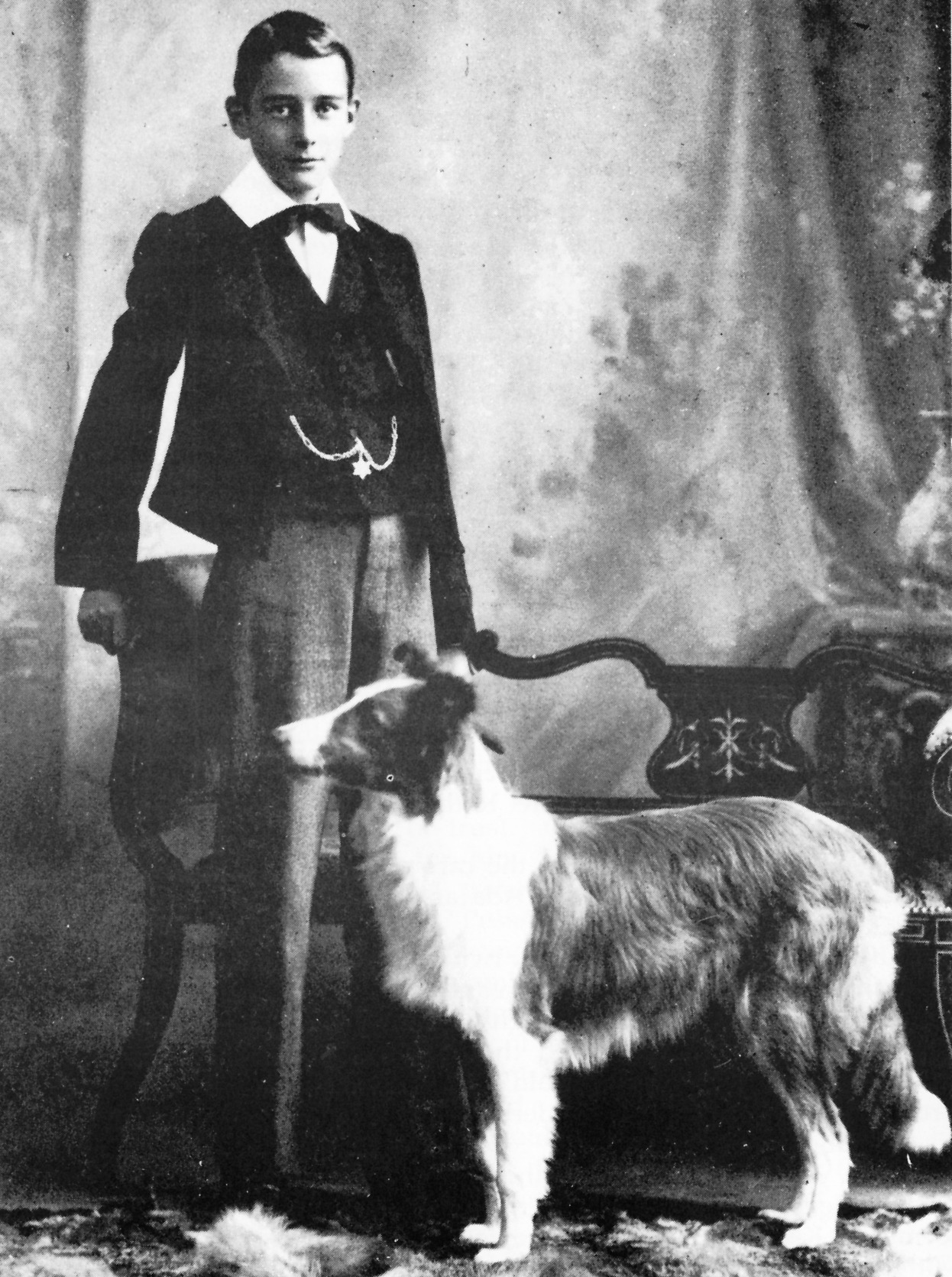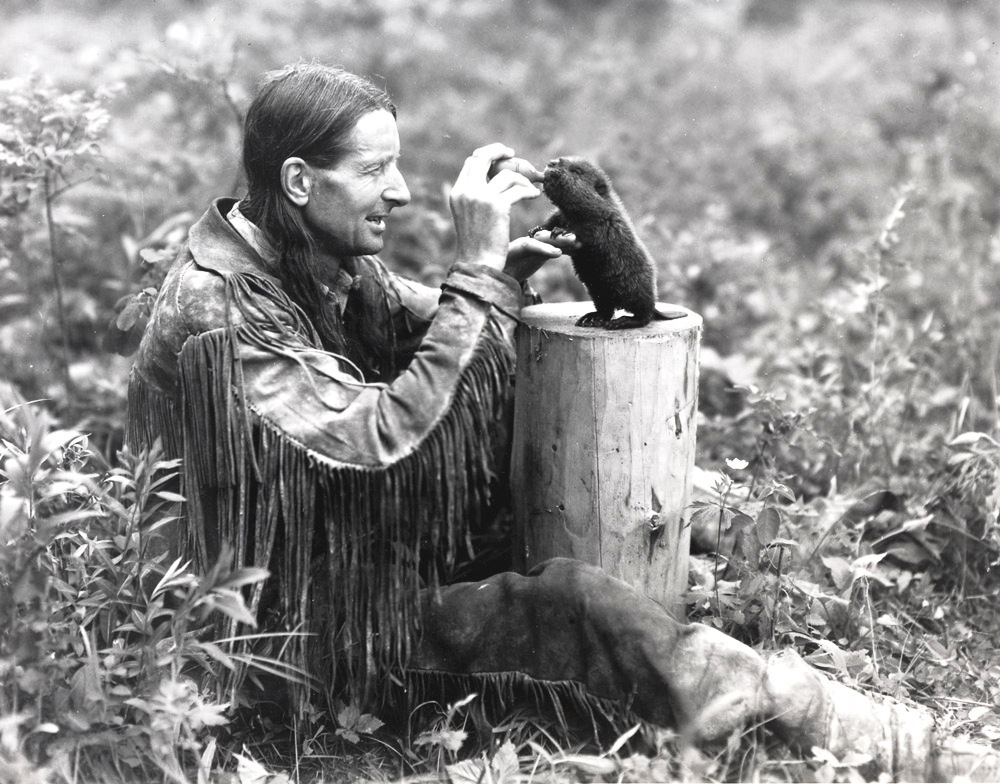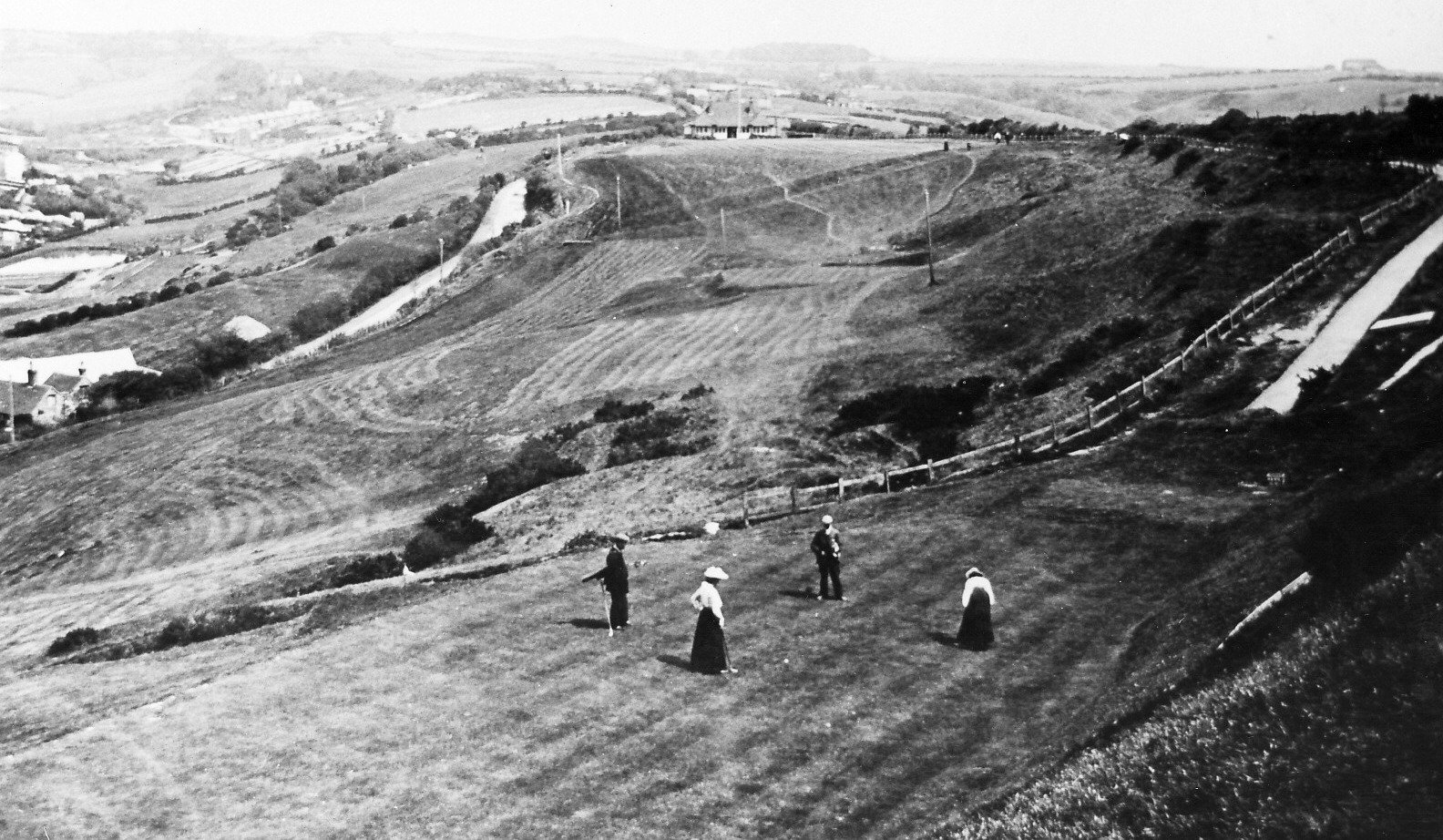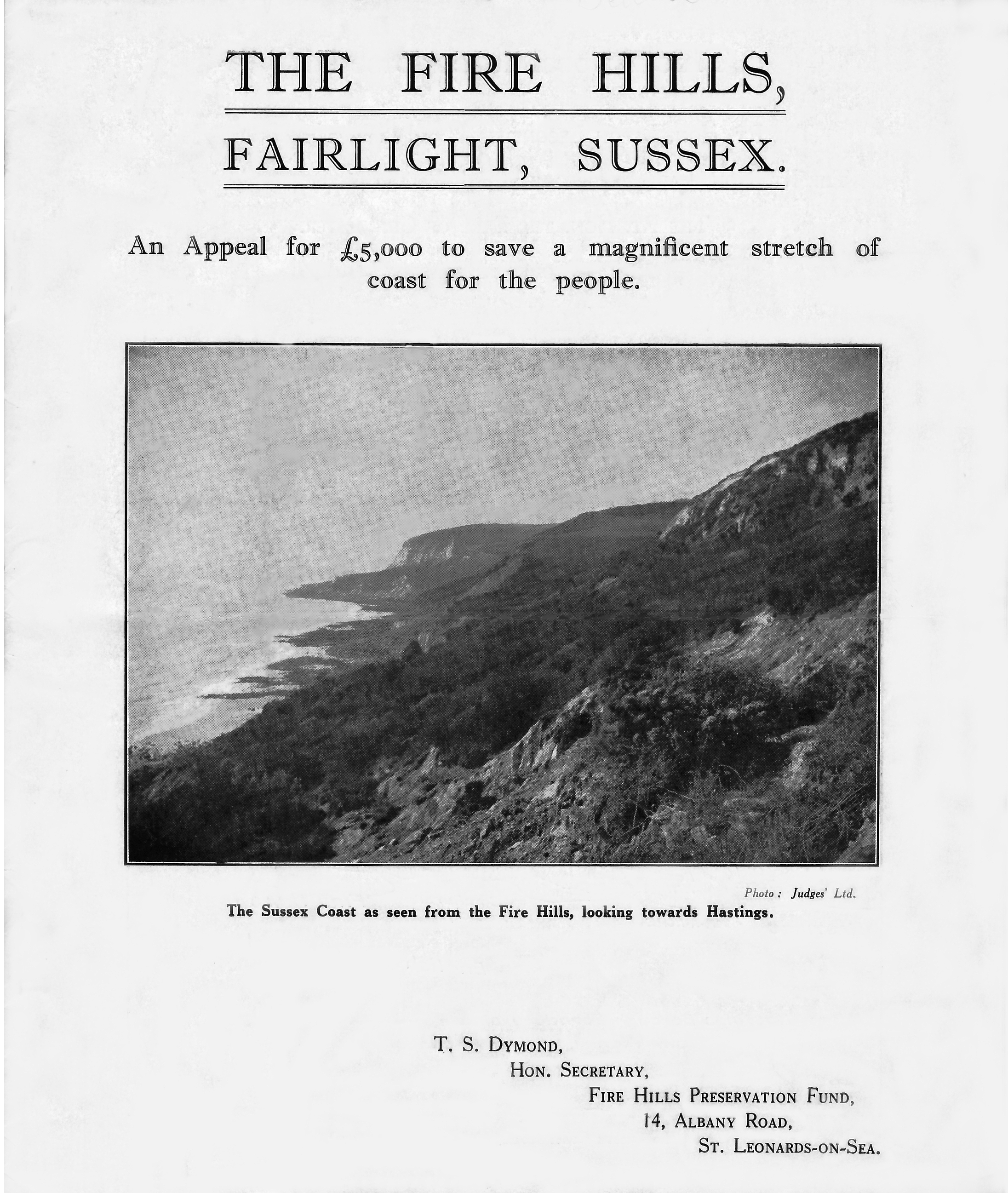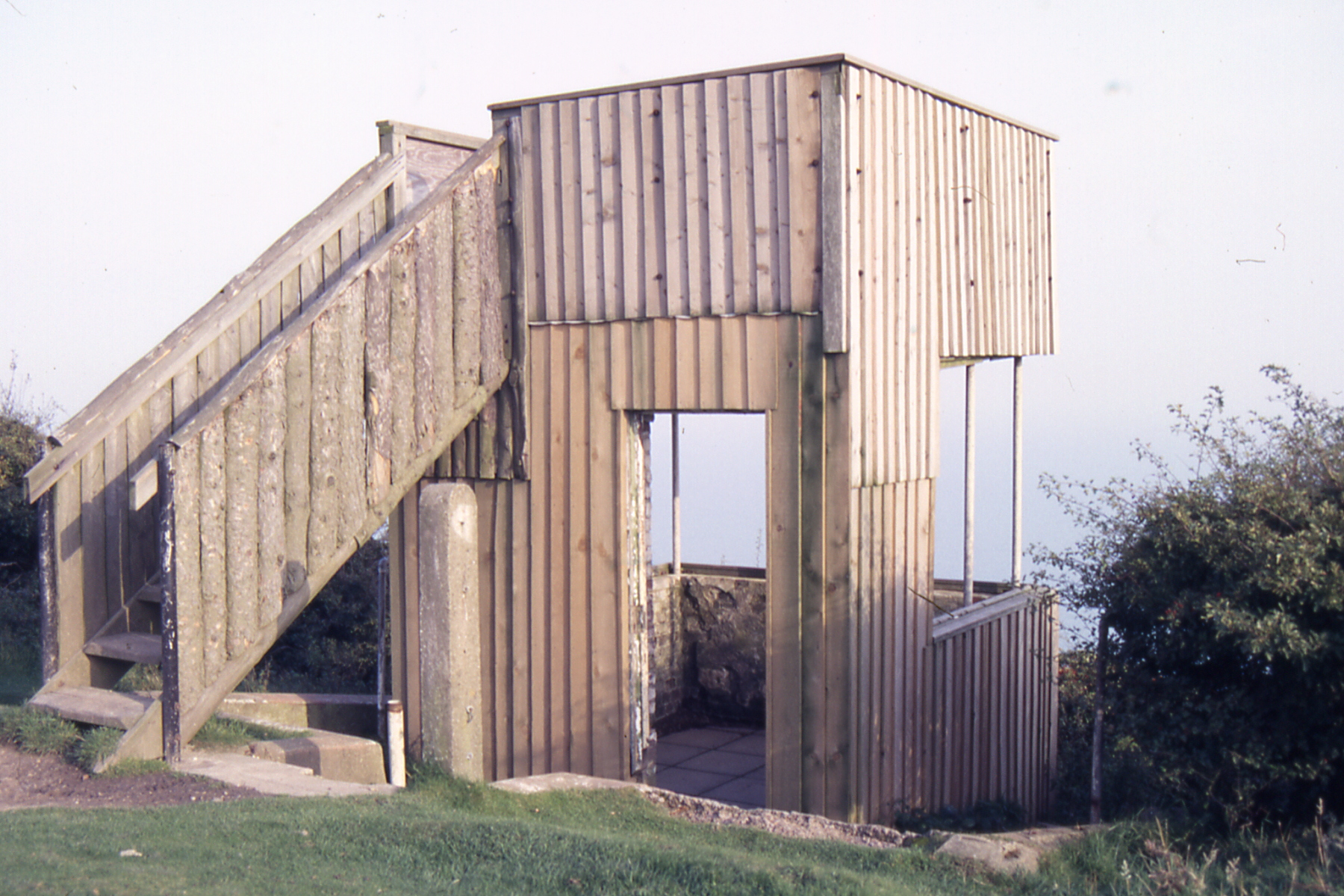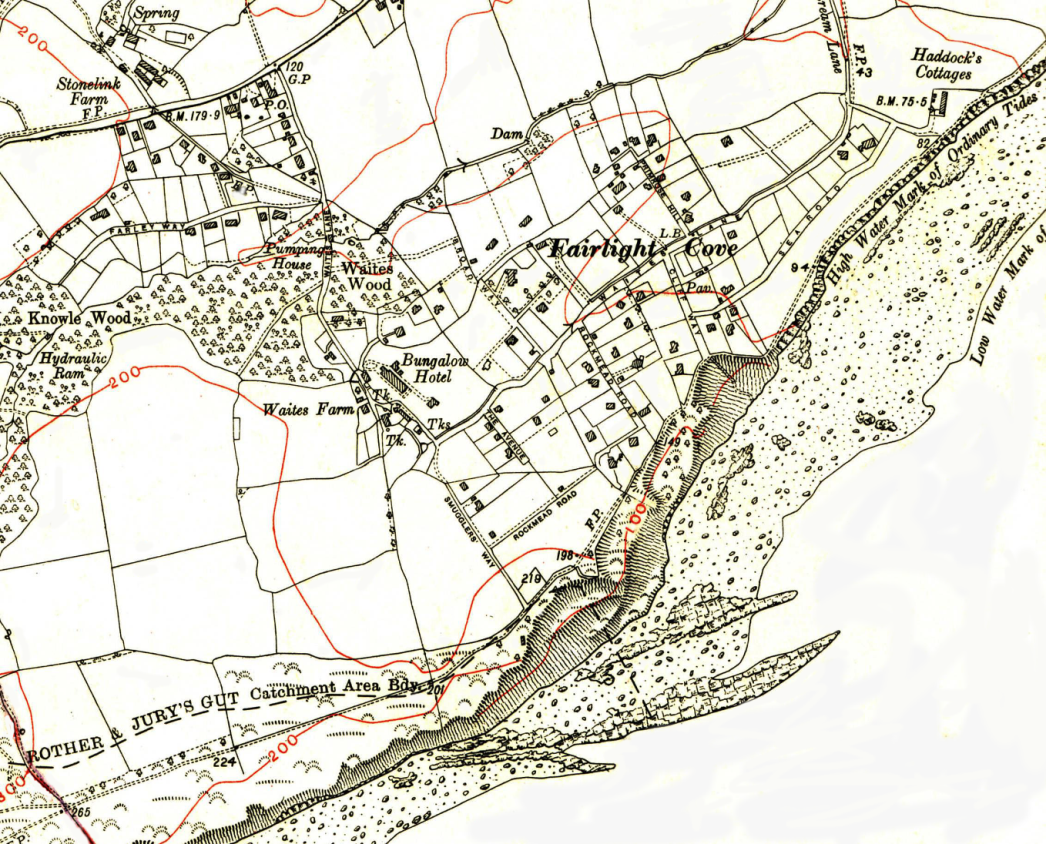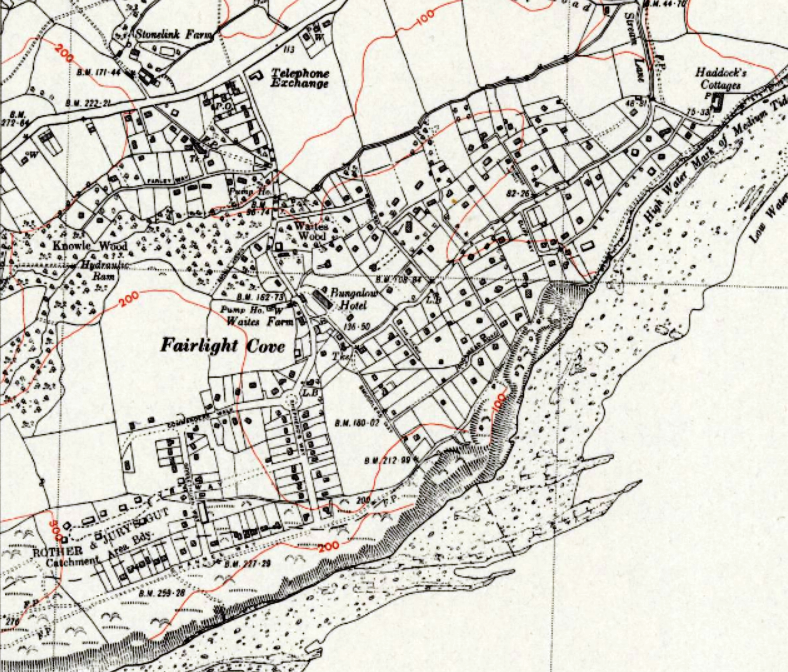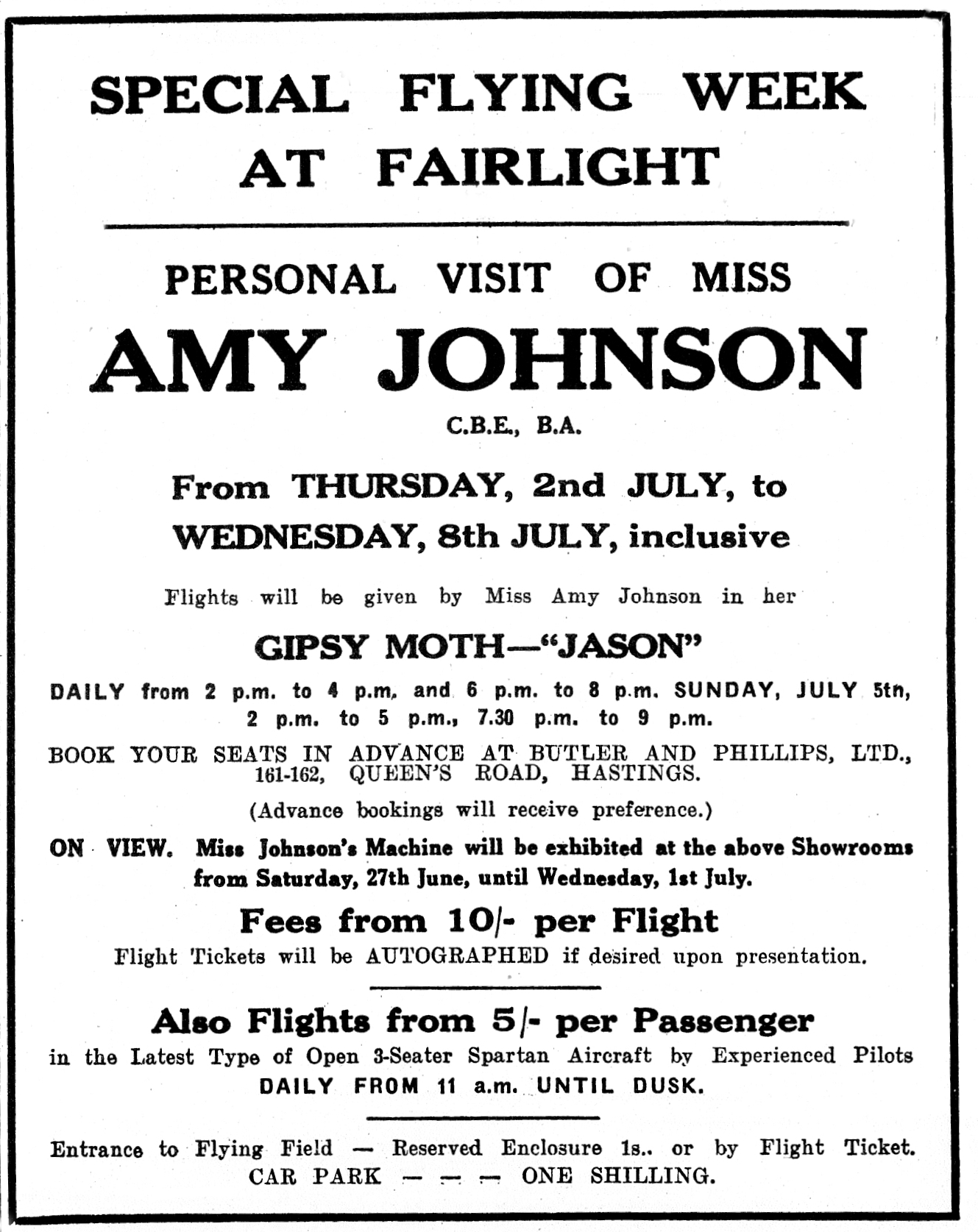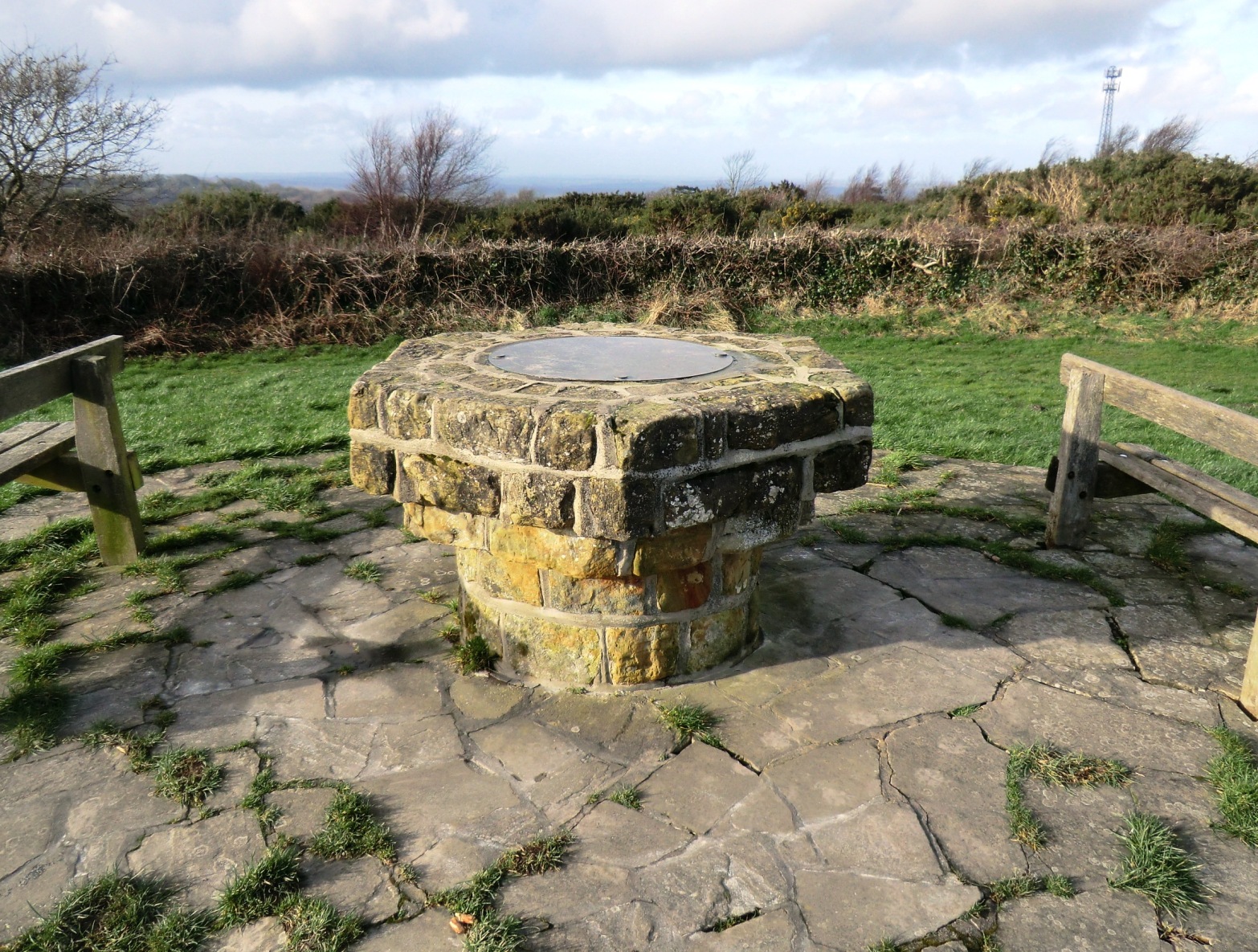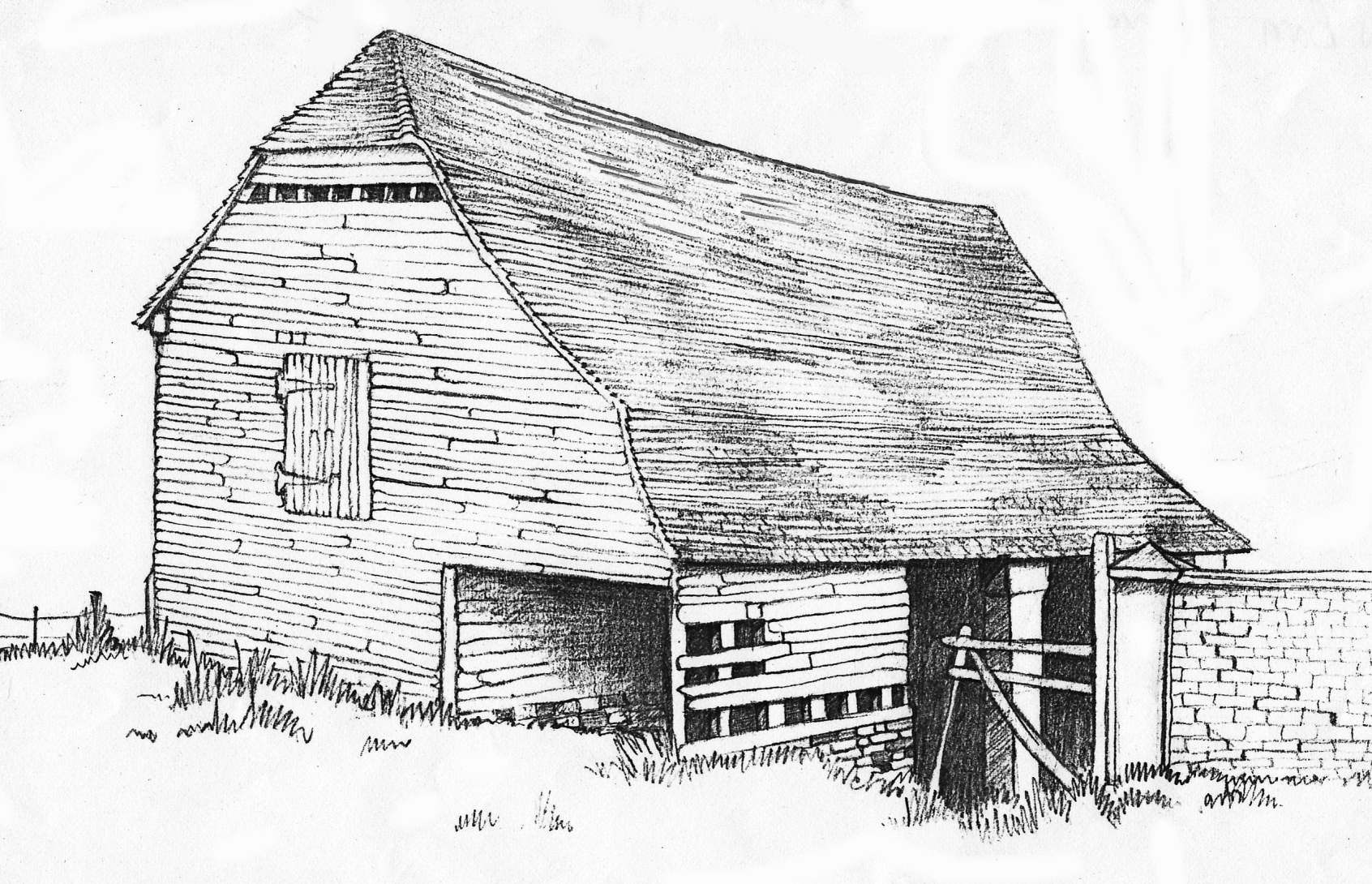1900-1949
1901 Feb 15 - A Council meeting gave the go-ahead for the construction of the East Hill Lift. It would rise 148 feet vertically, with its rails covering 258 feet. It would be run by water balance, with the pumping fuelled by the ‘Dust Destructor’ (refuse burning plant) at Rock-a-Nore. It would run beside the steps going up from Tackleway. The cars would hold 20 people and would take a minute and a half to run. The total cost would be £5,100. The landowner, the Rev Sayer-Milward, had been generous over the matter. Some councillors doubted that it would pay for itself. During the works, human remains and part of a mortared wall were found, plus several 'enormous thick' skulls and a spear described as of Saxon date.
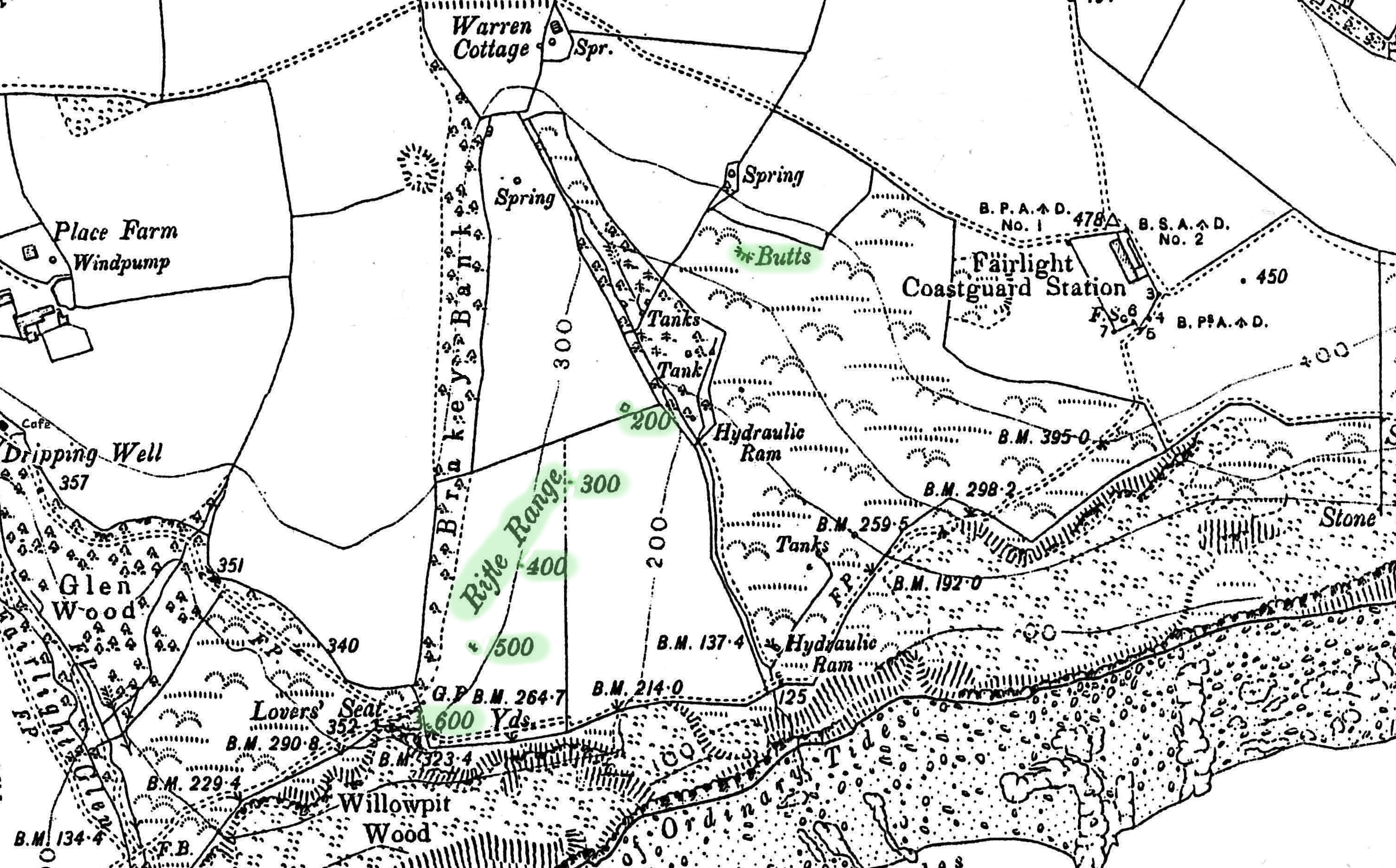 The 1901 rifle range in Warren Glen, highlighted on the 1908 OS map.
The 1901 rifle range in Warren Glen, highlighted on the 1908 OS map.
1901 May 6 - There was an opening ceremony at the new rifle range in Warren Glen. Mrs Sayer-Milward fired the first shot. The site was provided on long lease at a nominal rent by the Rev Sayer-Milward. The firing points were on the west side of the valley, facing north-north-east at two targets standing in front of a high bank on the east side. The point for the longest range (600 yards) was only a few yards over the bank by Lovers' Seat, while the 200 yard point was considerably raised, forming the roof of a magazine and store. It was on almost the same site as the rifle range set up by the artillery volunteers in 1862. The Ecclesbourne Glen rifle range had become over-crowded, having had to accommodate five rifle companies, two artillery batteries and the Coastguard men.
1902 Feb - A large portion of the cliff gave way at what was then called Target Hill, on the east side of Ecclesbourne Glen where the rifle targets were, not far from the footpath.
1902 May - The Golf Club gave up its six holes on the public part of the East Hill and six new holes were made off Barley Lane so that the whole course was then on private ground.
1902 Aug 10 - The East Hill Lift opened to the public for the first time. It was said to be the steepest in Britain at 1 in 1.28. The Hastings Mail of 16 August reported that it had been well patronised in its first week, with an average of 1,200 passengers per day. The Mail of 9 August said that the lift had been confirmed as being ready to start, following final trials on Monday 4 August: 'After being in hand for over two years, the East Hill Lift is at last in working order. It was originally contemplated that the work would be finished last year, but the excavation of the track took longer than was thought. The final trials took place on Monday. The cars were loaded up with iron to the extent of over 2 tons, and the tanks filled with water. The cars were then set running, and when they had attained a good speed, and were about five-eighths down the track, the ropes were cut to test the safety gear which is fixed underneath the cars.' The safety gear came into action automatically and stopped both cars simultaneously and without shock. 'This test showed that there was no danger in the event of the ropes giving way, though this is practically impossible, as each car is supported by four steel ropes one and a quarter inches in diameter.' The brakes were worked by hand, but there was also an 'automatic governor' which applied the brakes if the cars went too fast. At the side of the track was a flight of steps set in concrete, so if the cars stopped the journey could be completed on foot. 'The power for working the lift is the water balance principle. A large tank is fixed underneath each car, between the steel framework, and on the car reaching the top it automatically strikes against a lever connected with a valve which starts water for filling the tanks. When a sufficient amount of water is in the tanks the operator closes the valve by a lever which is at hand, the brake is lifted at the required moment, and the car begins the downward journey. On reaching the bottom another lever is struck automatically, and the tank is emptied, the water being pumped to the top again through a pipe running up the side of the track. The time taken to fill the tank and empty it is only a fraction of a minute. The contractors were Messrs Easton & Co, of Erith Ironworks, Kent, 'the largest builders of lifts in the world'. The Mail understood that the directors of the West Hill Lift had asked Easton about the possibility of converting their lift to the same principle as the East Hill. The Mail reporter had a ride in the lift on Tuesday 5th: 'True, there was a little bump at the bottom, but it was understood that that would be easily remedied.'
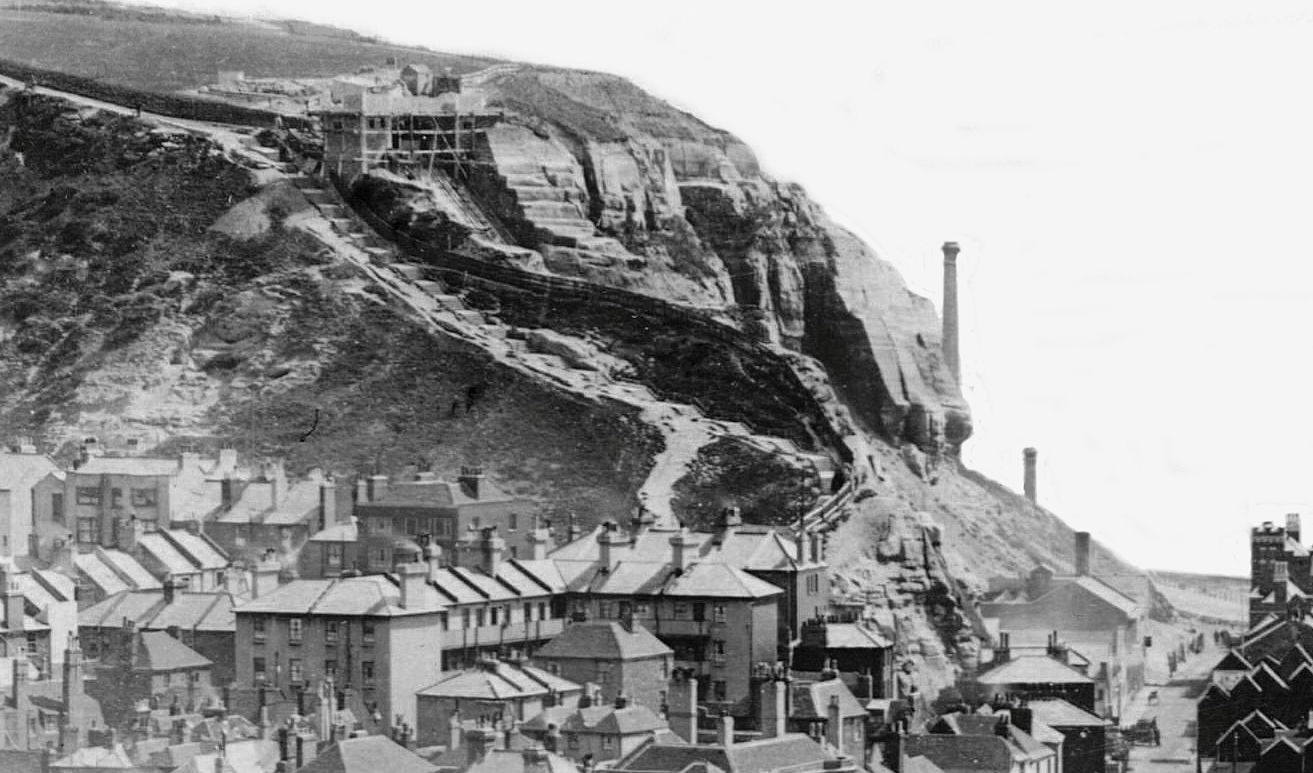 The East Hill Lift and the steps beside it being built in 1900-2.
The East Hill Lift and the steps beside it being built in 1900-2.
1902 Sept 22 - There was an alarming incident on the East Hill Lift, with a man dashed through a window and several passengers injured. The downward-going car increased speed rapidly and came into violent collision with the buffers at the bottom. Mr Osborne was thrown through the window onto the landing stage. The up-going car had also increased speed and had smashed into the upper buffers and its windows smashed. On 23 September a Parks and Gardens Committee inquiry into the accident suggested water in the tanks was not properly adjusted for a down-car loaded with passengers and an up-car which was empty. There was no hint when the lift might re-open. A similar crash was to happen in 2007, putting the lift out of action until 2010.
1903 Jan 16 - A council meeting agreed to publish their official report on the lift accident. It said that the lift staff were to blame. The 'rather serious accident' happened about 5pm on Monday 22 September. There were '13 passengers in the descending car, and none in the ascending, and the descending car, instead of being steadily brought to a standstill, dashed against the bottom buffer with the result that all the passengers were more or less shaken, and in some instances cut and bruised.' Only one was serious. Both cars were 'somewhat damaged'. After the accident, the town clerk wrote to the contractors, Easton & Co, saying 'it was attributable to the insufficiency of the brake gear provided by them under their contract'. But on 3 October the Parks and Gardens Committee were shown a letter from Easton 'stating that the evidence before them pointed to the accident being due to an error of judgement on the part of the brakesman, in applying the brakes, rather than to any failure in the brakes themselves.' Easton said they were happy to repair the lift, but would accept no responsibility. After hearing a detailed report from the borough engineer, the committee concluded 'that the accident might have been avoided by the exercise of more care and discretion by the attendant in charge of the top station.' There was a telephone connecting the two stations, but it was not used on this occasion, so the man at the top did not know there was no one in the ascending car, whilst his was nearly full. As a result the descending car went down too quickly and the brake could not stop it in time. The committee also concluded that the accident showed there were defects in the design of the brake system, so they commissioned Easton to add a separate, independent brake to make it absolutely safe. The lift was kept closed until that was completed. A total of £231 15s 6d was paid in compensation to the injured. The lift was about 270 feet long. Each tank held about four tons of water. The supply tank at the top had sea water pumped into it. Each carriage took 16 people. The man at the top delivered enough water into the tank of the car at the top to make it descend; he judged the amount according to the number of passengers in each car. He also controlled a brake to slow and stop the descending car. It re-opened on 9 April 1903, the day before Good Friday, and had 41,000 passengers in the first 16 weeks.
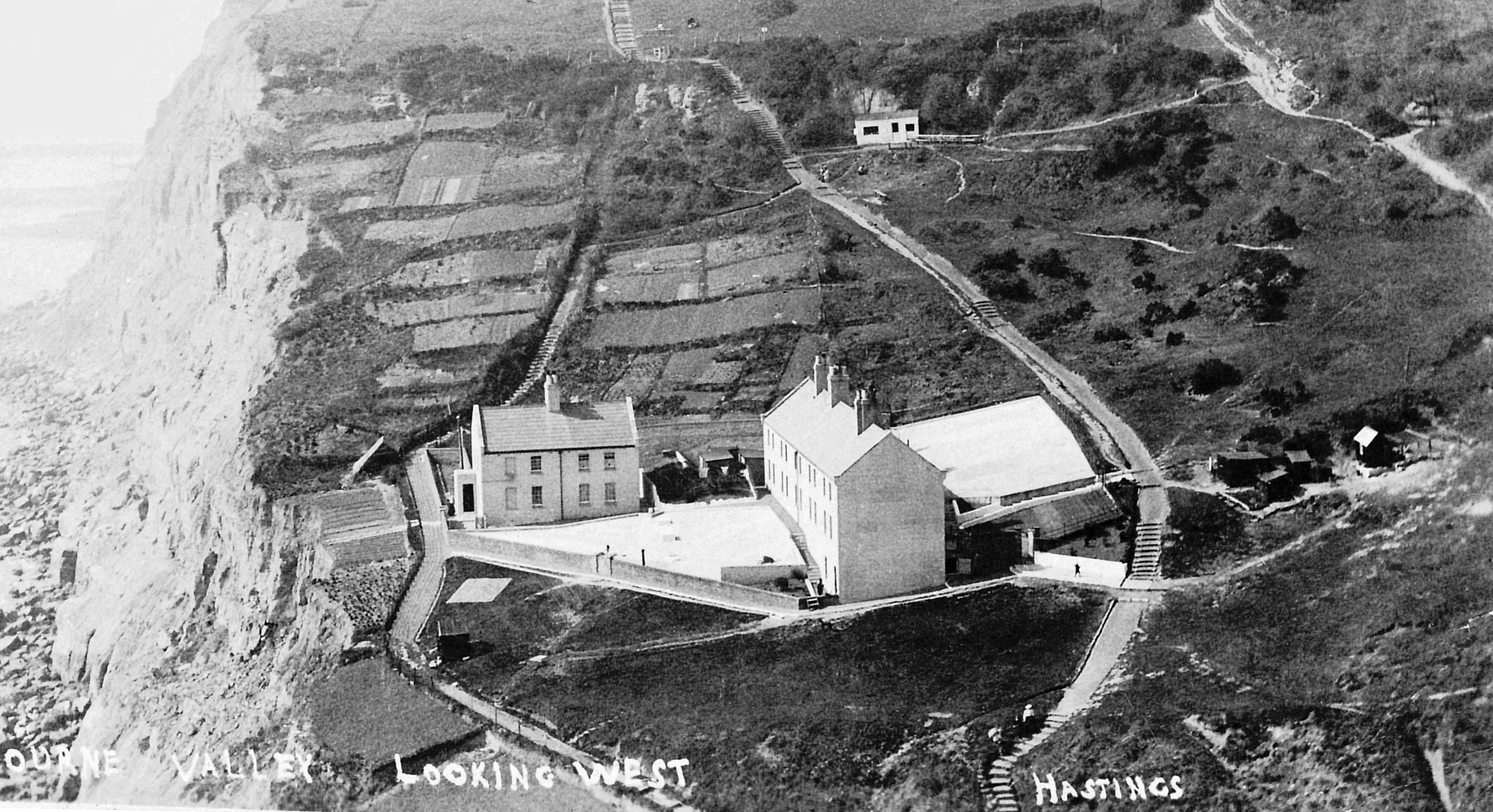 The Ecclesbourne Coastguard Station in the early 1900s, shortly before it closed, with its 'garden' still well used. Today the cliff edge is roughly between the two buildings, and the only path now is in the top right corner.
The Ecclesbourne Coastguard Station in the early 1900s, shortly before it closed, with its 'garden' still well used. Today the cliff edge is roughly between the two buildings, and the only path now is in the top right corner.
1904 - The Fairlight Coastguard Station was rebuilt on its existing site, on Fairlight Head. It formed the terrace of houses still there today, with lookout facilities on the seaward end of the block. At about this time, and in immediately following years, the government cut down the size of the national Coastguard service, and this seems to have resulted in the closure of the Haddocks and Ecclesbourne Stations, with Ecclesbourne closing in 1908 (a local newspaper in April 1909 described it then as 'deserted').
1904 - At this time, the main feature of Ecclesbourne Glen was the Coastguard Station and its surrounding gardens. Nearby were cafes for the many members of the public who regularly walked along the cliffs and through the glen. Inland on the west side of the glen, where now there are just trees and shrubs, was a line of five allotments, commonly known as the strawberry garden. At the head of these plots was a cave, with its long-term resident being the ‘Hermit’, Mr John Hancox. He was called the East Hill Hermit as no one then knew his name. He was a former London businessman, in the drapery trade. He came to Hastings around 1893, being near-bankrupt after a friend failed to repay a large loan. He decided to live a solitary life, dependent on no one, and he became a ‘squatter’, living in various places around the town, until ending up in the cave in Ecclesbourne Glen. When the cave’s landlord, the Rev Sayer-Milward, discovered it had an occupant, he gave Mr Hancox a tenancy for 22s 6d a year (plus rates of 2s 6d). For this the Hermit had both the cave and the plot in front of it. He then put up a hedge around his ground, with a big wooden gate, and stayed there for the rest of his life. He first became widely known in 1904, following a report in the Hastings Mail. This said: 'Tanned, and not too well groomed, he is by no means unkempt or dirty. His dark clothes are of a good cut and patter, although obviously of years ago. He wears a cloth cap, and his features still bear traces of refinement and breeding.' The Hermit 'is alone and poor but he never asks alms of anyone, although many folk kindly minister to his needs. He sings and talks to himself alone. He needs no other - he very rarely answers questions.' The Hermitage, as the cave was called, had very little in it, apart from a stove, which had been given to him. But, the Mail said, there were other hermits in and around the glen, who were not so attractive. About 100 yards up the valley was an alcoholic living in another cave amongst the trees, who made a lot of noise at night, singing and shouting while under the influence. The Mail described how there were also several 'untraceables' to be seen in the area, gathering limpets at low tide and lurking in farmyards before dawn. 'Some times they sleep as honest men. But they are predatory by instinct for the most part.' The Hermit was a well-known feature of the glen for many years. Then in November 1918 he was found dead in his cave one morning by his only friend. Aged 74, he had died of 'natural causes' while asleep. His body had been partially eaten by rats. The coroner heard that there was no bed or furniture in the cave, but there were many books, plus firewood. The cave itself was about ten feet square,
with a pitch of eight feet. His friend said he was a well-educated, intelligent man, who was very happy. He neither had, nor wanted, other friends, and he spent much time singing. He had lived on his small savings, plus every day he searched pig tubs and dustbins in the town, on which he survived. It was believed he had a daughter in service in Hastings. The Hermitage has had many other dwellers, both before and after Mr Hancox.
1906 March - Local youngster Archie Belaney (1888-1938) set sail for Canada, where he converted himself into the indigenous Grey Owl, and achieved world-wide fame as an ecological conservationist. It was only after his death that it was revealed that his Canadian life-story had been fictional, and that he was Hastings born and bred. He had an unhappy childhood, and while at Hastings Grammar School he developed a love of natural life, especially animals, and often explored what is now the Reserve. He published several books in the 1930s, the first being The Men of the Last Frontier (1931).
1908 Sept - The outfall of the Rock-a-Nore sewer pipe was partially destroyed in a severe gale. It took nearly two years to fully restore it. The pipe came in sections nine feet long, four feet in diameter and weighing about four tons.
1910 March - Recent cliff falls caused damage to the surroundings of Lovers' Seat. Most notably, the large sloping rock that had stood near the seat had slipped down the cliff, and ground in front of the seat had fallen away, leaving it almost on the edge of the cliff.
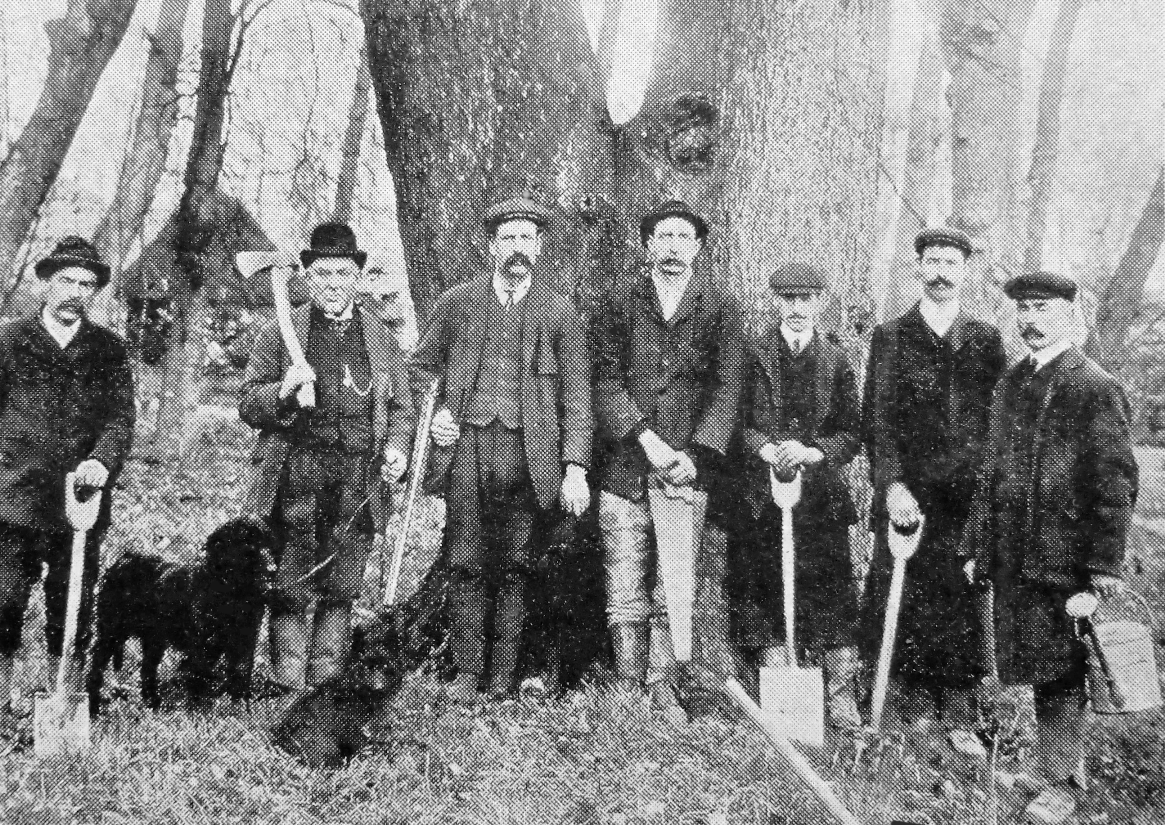 Some of the Reverend's workers, in March 1911.
Some of the Reverend's workers, in March 1911.
1913 - Death of the Rev William Sayer-Milward, born in 1837, who had controlled the Milward Estate since 1890. It passed to his widow, Edith Sayer-Milward (1847-1935).
1914 June 13 – Intrepid young aviator Frank Goodden gave a sensational exhibition of flying at Fairlight. Large crowds of people gathered to watch Mr Goodden spend half an hour circling and looping the loop in very strong winds. Unfortunately, many of these people refused to pay to enter the fenced-off area (probably in the field to the west of the church) to see the display, and instead watched it free of charge from outside the fence. Mr Goodden flew from Tunbridge Wells for the display, in a Morane monoplane, made by Gustav Hamel. He gave another demonstration at Fairlight on 17 June. Mr Goodden, born 1889, was killed in January 1917 when the new Sopwith SE5 fighter he was testing for the RAF broke up.
1917 Nov 24 - The ownership of much of eastern Fairlight was changed when most of the Lucas-Shadwell family’s Fairlight Hall Estate was auctioned at the Castle Hotel, Hastings. This followed the death of William Lucas-Shadwell (1852-1915), Conservative MP for Hastings 1895-1900, the only son of William Drew Lucas-Shadwell who had built Fairlight Hall in 1850-51. A total of 3,680 acres was sold, covering an area from Fairlight Chuch along the coast to Rye Harbour, taking in most of Pett as far north as the Pannel Sewer. This included the Fairlight farms of Marsham (then 231 acres), Warren (325), Waites (153), Wakeham’s (69), Stonelink (52) and Lower Stonelink (49). Mrs Lucas-Shadwell kept the Haddocks Cottages, the former Coastguard Station, as summer residences. It was probably in this sale (although possibly in 1921) that Edith Sayer-Milward bought part of Warren Farm, extending the Milward Estate east to Coastguard Lane, plus taking in the west end of the Firehills (to about 250 yards east of the Coastguard Station). The rest of Warren Farm, plus Waites, Wakeham’s and Stonelink Farms (and possibly others) were bought by Lord Rothermere, the right-wing newspaper magnate who in 1896 had started the first tabloid daily paper, the Daily Mail. He bought this property as a wedding present for his son, the Hon Esmond Harmsworth MP, who briefly lived in the Warren farmhouse (his first daughter was to be the wife of Hastings MP Neil Cooper-Key). But Esmond sold most of it in 1921. After the Fairlight Hall sales were completed, the contents of the mansion and the estate's workshops were sold by auction in May 1920. The 'valuable antique and modern household furniture' included Chippendale chairs, a mahogany billiard table and a 'grand pianoforte'.
1919 June 28 - Mrs Sayer-Milward auctioned over 1,200 acres of the outlying portions of the Milward Estate. This included Scutes Farm at Ore, Rocks Farm at Guestling, Winterstow Farm at Fairlight, the Kings Head Inn at Ore, Lidham Farm at Guestling, Newbarn farm at Fairlight and about 700 acres of small holdings, woods, accommodation land and building sites. She was noted for her generosity in supporting worthy local causes.
1920 Sept 11 - Hastings Council had asked the Board of Trade to promote the setting up of an optical glass-making industry in Hastings, to help give work to the many unemployed people in the town. But the Board told councillors that it did not think that such a business in Hastings was viable, and suggested instead that unemployed people could be given jobs at the sand quarry on the west side of Coastguard Lane in Fairlight, between Church Farm and the Batley Almshouses (built 1892). This quarry is not on the 1839 tithe map, but is on the first large-scale Ordnance Survey map of 1873, so it may have been started for the building of the church in 1845-46. In the quarry’s geological formation there was snow-white Ashdown sand (Wealden), which could be extracted and sold on to glass manufacturers and other sand users elsewhere. In 1925 British Sands Ltd advertised sharp sand and rockery stone for sale. By 1928 new buildings had been erected in the quarry, although its area was to remain unchanged until 1939. There was also much of this white sandstone at an old quarry about a quarter of a mile west of the church, close to Fairlight Road.
1920 Sept 25 - The Hastings Observer published a drawing, dated that September, and headed 'A Disappearing Landmark', showing 'the picturesque, but decayed, Barley Lane Farm House'. The town’s first council houses were about to be built where the farm was, and the farm buildings were to be demolished. The farmhouse and its attached small barn were built of stone, with a separate wooden shed nearby. They all stood where Nos 47 and 49 Barley Lane are today, a few yards uphill from the Gurth Road junction.
1920 Oct 8 - An auction was held at Fairlight Place Farm of the equipment of Mr AF wood, who was quitting the farm. Included were 'three powerful cart horses, 14 cows, 13 lusty store cattle, eight pigs and a superior lot of implements'.
1920 Dec - Tilekiln Farm was sold by Mrs Sayer-Milward to Thomas Smith for £3,700. This included about 49 acres, including Pinders Shaw and the fields north-west of it, at the top of the Bourne Valley.
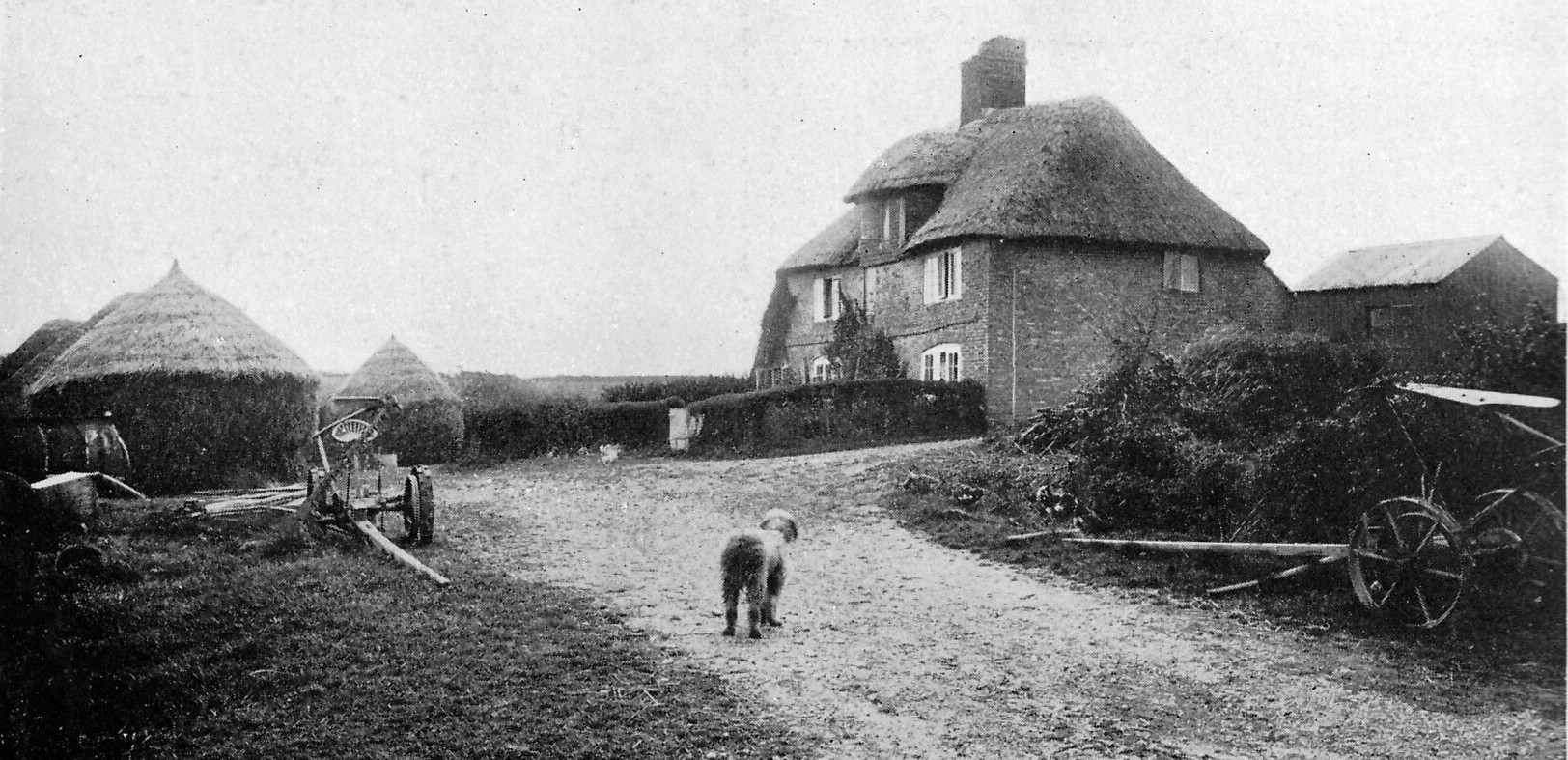 Waites Farm above, and some of the early housing, on Channel Way.
Waites Farm above, and some of the early housing, on Channel Way.
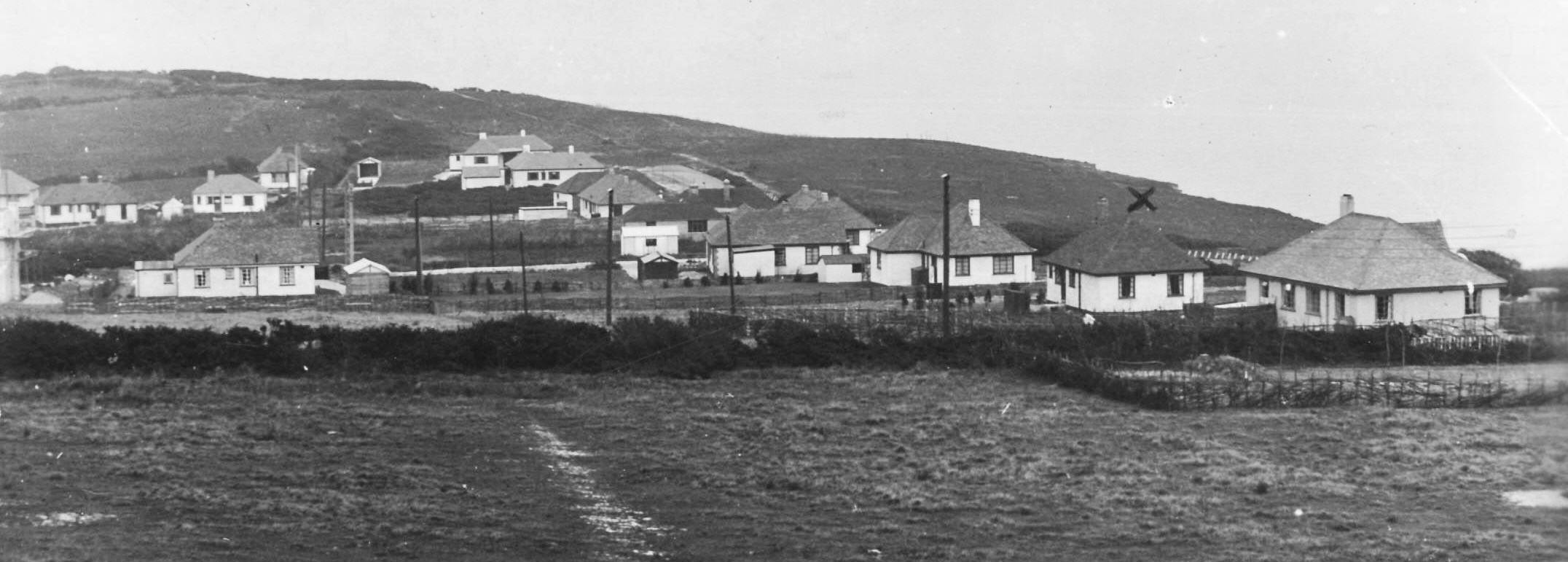 1921 March 30 - Esmond Harmsworth auctioned Waites Farm (then 226 acres), Wakehams Farm (40), Lower Stonelink Farm (34) and Chisholme Farm (17½), plus marsh land at Pett and 11 cottages at Pett, while retaining most of Warren Farm. A month later, on 29 April, all the equipment of Wakehams Farm and Waites Farm was auctioned at Wakehams, including eight cart horses, 64 cattle and 24 pigs. But in late 1922 Harmsworth sold Warren Farm to Mrs Mabel Ethel Schoneboom, and in January 1923 he auctioned the farm’s livestock, including 37 cattle, 93 sheep and 75 poultry. Mrs Schoneboom began major investment, in July 1923 putting up for auction 32 'fine freehold building sites at the Warren Farm Estate'.
1921 March 30 - Esmond Harmsworth auctioned Waites Farm (then 226 acres), Wakehams Farm (40), Lower Stonelink Farm (34) and Chisholme Farm (17½), plus marsh land at Pett and 11 cottages at Pett, while retaining most of Warren Farm. A month later, on 29 April, all the equipment of Wakehams Farm and Waites Farm was auctioned at Wakehams, including eight cart horses, 64 cattle and 24 pigs. But in late 1922 Harmsworth sold Warren Farm to Mrs Mabel Ethel Schoneboom, and in January 1923 he auctioned the farm’s livestock, including 37 cattle, 93 sheep and 75 poultry. Mrs Schoneboom began major investment, in July 1923 putting up for auction 32 'fine freehold building sites at the Warren Farm Estate'.
1922 - Development began on part of Waites Farm, starting what is today known as the Fairlight Cove estate. The eastern half of the estate, along Lower Waites Lane, appears to have been mostly sold by Harmsworth to a Capt RE Philp, who then sold building plots individually, and thereby created the rather disorganised ad hoc layout of today’s Cove, then initially known as the Waites Estate. In October 1924 Capt Philp advertised 'Freehold plots, from half to five acres, from £95; six-roomed bungalows built to order from £515.' Most of the Waites Estate houses were wooden bungalows, of random design. The western half of the Cove was purchased from Harmsworth by a syndicate known as Fairlight Estates. This became incorporated as Fairlight Estates Ltd in the spring of 1928. The company set about building what they called the Fire Hills Estate by first constructing the roads Shepherd’s Way and Channel Way. They then constructed a laid-out estate of better-designed houses than those on the eastern Waites Estate. The Fairlight Estates chairman was the Hon Frederick Hamilton Smith (1888-1931), eldest son of the First Baron Colwyn (1859-1946). The baron was owner of a rubber and cotton factory and deputy chairman of Martins Bank. The company owned the Waites Farmhouse and its adjoining buildings, including a cowshed and barn. In 1923 the cowshed was converted to become the main part of large 40-bed Fairlight Cove Hotel, which was built at the great cost of £6,700 by a Mrs Mabel Schoneboom, with a lease from the syndicate. The hotel, which had extensive grounds and gardens, has had various names over the years, including the Bungalow Hotel, the Cove Hotel and even the Fairlight Cove Bungalow Hotel!
1922 June 17 - Major Alfred Carlisle Sayer, owner of Fairlight Glen, said in the Hastings Observer that 'beautiful though the [Glen] is, it would be much more beautiful during the summer months if visitors would refrain from leaving paper, banana skins, etc, all over the ground. There are provided at frequent intervals wire baskets in which people are invited to put such rubbish. ... It seems to me a very great pity that so beautiful a place should be disfigured to the extent to which it is year after year by this rubbish thrown about.'
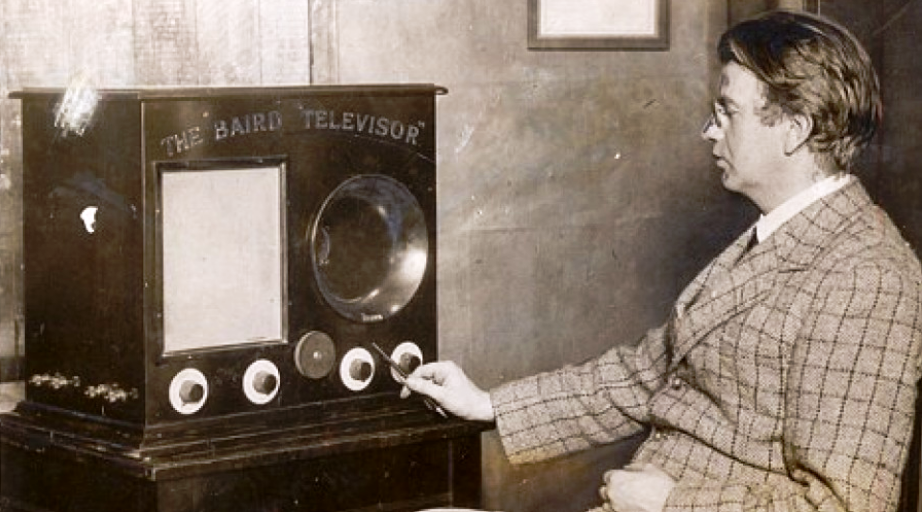 John Logie Baird.1922 - The television pioneer Scotsman John Logie Baird (1888-1946) came to Hastings to recover from a severe illness. Being an inventor short of finance, he needed to create something that would bring an income. He later recalled: 'More thought was needed. I went for a long walk over the cliffs to Fairlight Glen, and my mind went back to my early work on television. Might there not be something in it now?' He came up with what seemed like a feasible system, went back to the house in Linton Road where he was staying and explained it to the friend that he was staying with. Together they put together a crude mechanism - and it worked, transmitting the world’s first-ever television pictures.
John Logie Baird.1922 - The television pioneer Scotsman John Logie Baird (1888-1946) came to Hastings to recover from a severe illness. Being an inventor short of finance, he needed to create something that would bring an income. He later recalled: 'More thought was needed. I went for a long walk over the cliffs to Fairlight Glen, and my mind went back to my early work on television. Might there not be something in it now?' He came up with what seemed like a feasible system, went back to the house in Linton Road where he was staying and explained it to the friend that he was staying with. Together they put together a crude mechanism - and it worked, transmitting the world’s first-ever television pictures.
1923 October - The Hastings Rural District Council was told that the Waites Estate was becoming 'quite a bungalow farm', with about three to an acre. Waites Farm was still partly a farm until June 1925, when its last animals and equipment were auctioned. The area had started becoming known as Fairlight Cove by 1925-26. Its steadily increasing size prompted the purchase of the Firehills by Hastings Council in 1927, in fear of the development spreading westward.
1923-4 - The height of the dam of the Spoon reservoir in Ecclesbourne Glen was raised, and the reservoir’s inside slope was improved, doubling its capacity to 12 million gallons. To do this, an additional two acres of land was needed, to add to the existing area of just over three acres, so the Council in November 1924 bought for £1,000 all that land from Edith Sayer-Milward, ending its lease. In March that year the 60 men at work on the reservoir went on strike for a pay rise. Ownership of the Spoon was transferred to the Southern Water Authority in 1974.
1924 - In late January there was a serious fall of cliff at the East Hill Lift, about three quarters of the way up. A large portion of the track was damaged and one of the cars was wrecked. A month later, on 26 February, the bottom station of the lift was burnt out, and one of the cars was damaged.
1924 Summer - The Hastings Golf Club moved into Fishponds Farmhouse, which was to be its base until 1958. Until 1924 its clubhouse had been at the junction of Barley Lane and Rocklands Lane. But four of its course holes were in the field lower down Barley Lane, opposite the new council housing estate on the lane and Boyne Road, making those four holes difficult. The club’s AGM in February 1923 was told that, by chance, the tenant of Fishponds Farmhouse had died recently, so it was decided to lease Fishponds and its neighbouring farmland from the Milward Estate. The meeting was told that this could give the club a high-quality 18-hole course, in two lots of nine, and 6,147 yards long, on the ground between Fishponds and the sea. The February 1924 AGM heard that the scheme had gone ahead, at a cost of £2,200, including a 'considerable amount of alteration to the farmhouse'. They transferred to the new clubhouse just after Whitsun 1924, later becoming known as the Hastings Downs Golf Club. The barn next to the farmhouse was used for storing golf club equipment. The club initially ran its own six-a-day bus service from the town centre. Until 1936 the club had nine holes, with the other nine being added that winter.
1924 Sept 18 - All the 'superior household furniture and effects' of Shear Barn Farm were sold at an auction on the premises, in Barley Lane. Included were 'the handsome inlaid mahogany Sheraton patter bedroom suites' and a 'fine full-compass upright grand piano-forte by Neumeyer'.
1925 May 18 - A local man - Edward Willett (38), of Tackleway - survived a 200 feet fall over the cliff by landing feet-first in sand. He had been gathering broom into a basket on top of the cliff 100 yards east of Rock-a-Nore. He said 'Suddenly everything went "swimey" [dizzy]. Before I knew anything else I was falling. I hit the soft sand at the bottom of the cliff.' But the only injuries were a bruise on the forehead and a fractured ankle.
1925 Dec - There was widespread concern that the housing development taking place in Fairlight Cove would spread to the Fire Hills, while at the same time it became known that 42½ acres of the Fire Hills had been offered to Hastings Council for £1,530 (about £95,000 today). So in mid-December a campaign was launched to preserve these acres and some more nearby, launching a public appeal 'for £5,000 to save a magnificent stretch of coast for the people'. The appeal was endorsed by many well-known people, including the Earl of Chichester, the Countess Brassey and two MPs, with the mayor of Hastings acting as the treasurer. This was
successful, and 69 acres were eventually purchased from local resident Mrs Mabel Schoneboom for £2,000, and on 6 April 1927 the Prince of Wales witnessed the handing-over ceremony. But in 1927 a lease was granted to the Coastguard to build a small lookout in a prominent position in the Fire Hills, half a mile east of Fairlight Coastguard Station, and the Hastings Observer of 26 November 1927 commented 'The beauty of the Fire Hills has not been increased by this lookout'. Some of the remains of it can still be seen today. The new lookout was part of a reshaping of the local Coastguard in 1927/8. The large Marine Parade HQ Station was closed, with Fairlight Station replacing it as a much smaller base for all the Coastguards in the Hastings area. The Marine Parade building was renamed Sturdee Place, after Admiral Sturdee, and is now shops and flats. The Fairlight Station became the only constant-watch Coastguard Station between Newhaven and Dungeness.
1926 March 22 - There was a serious fire at the Firehills, covering about 50 acres, and most of the gorse was burnt down. But it was believed that the roots of the gorse would be unaffected, and that in about two years it would bloom again. There was another damaging fire in late December 1927.
1926 July 19 - The Hastings Observer reported that on this day at the Police Court 'Frederick Charles Baker, a young man of foreign appearance, with a sallow complexion, dark eyes and jet black beard' was found guilty of breaking in to a 'refreshment hut at Ecclesbourne Glen and stealing a quantity of sweets, fruit, matches and cigarettes'. He pleaded guilty to this and other similar crimes. The police said that 'prisoner had been living in a bivouac made of branches and constructed on a narrow ledge of cliff about 30 feet from the bottom. The bivouac could not be seen from the top of the cliff, and could only be approached from the bottom at low tide.' He was committed for trial at the next Quarter Sessions.
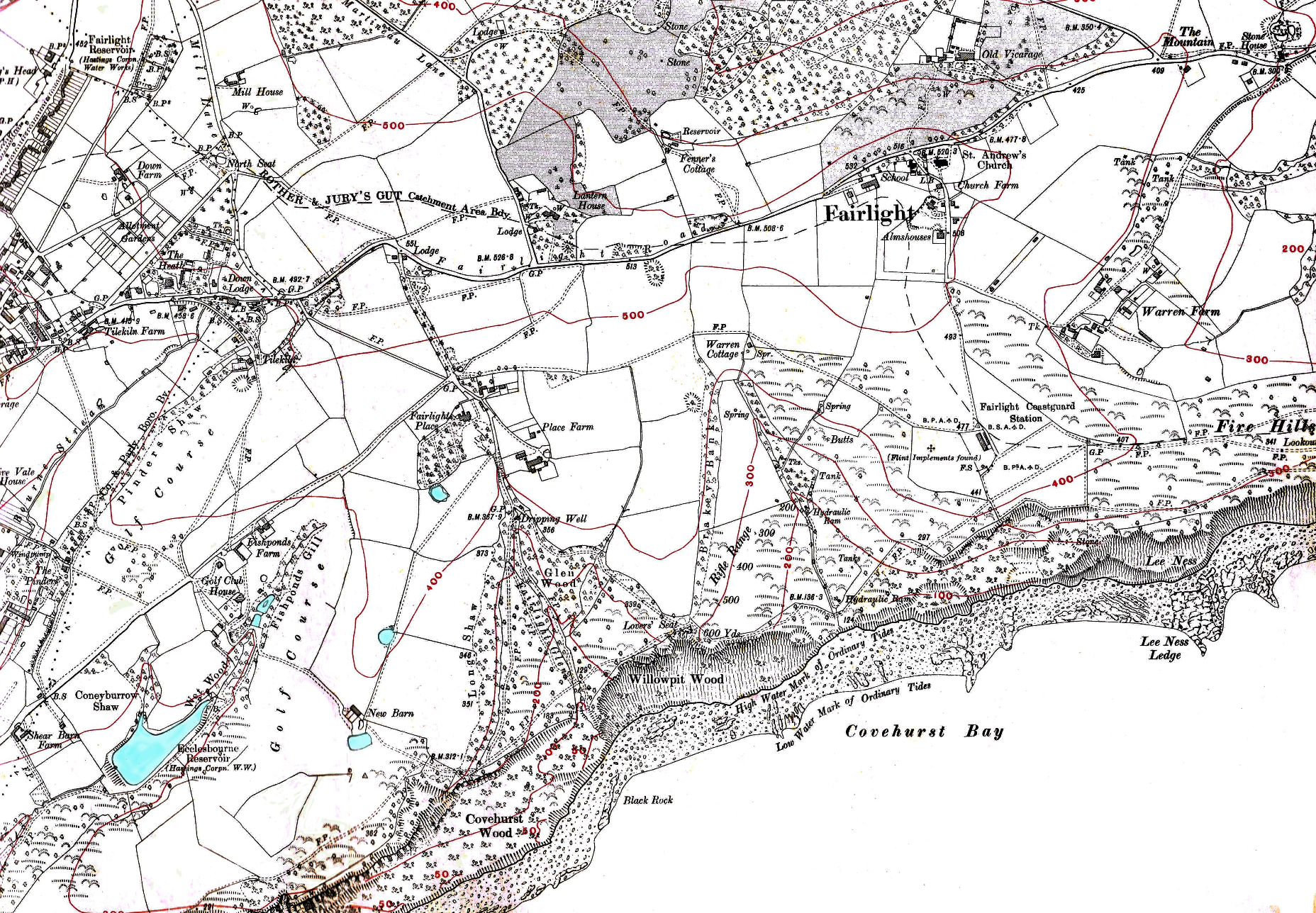 The east end of the Reserve in 1928. Barley Lane is shown extending as a footpath east to Fairlight Road, and Tilekiln Lane continues south as a path to Barley Lane. Both these paths, now gone, were probably medieval roadways.
The east end of the Reserve in 1928. Barley Lane is shown extending as a footpath east to Fairlight Road, and Tilekiln Lane continues south as a path to Barley Lane. Both these paths, now gone, were probably medieval roadways.
1929 March 11 - A major fire swept the Firehills and surrounding land. The Hastings Observer of 6 March reported there were 'four square miles of blackened countryside. … The fire raged all day and into the night, spreading from the Warren Estate [the west side of today’s Fairlight Cove], to Fairlight Church, to the Coastguards headquarters and to the approaches to Fairlight Glen itself.' Many people joined in the fire fighting, and there was no serious damage to any buildings, apart from some huts. The fire started at the north of the Warren Estate. 'In some places there was a solid sheet of flames two miles in length, advancing quicker than a man could run.'
1930 - By this year, development was under way on the Warren Estate, with houses being built on the south side of Fairlight Road, including the new Hill Road and the improved Warren Road. But in early January 1931 the chairman of Fairlight Estates Ltd syndicate, Frederick Smith, died, aged just 43. The syndicate had by then exhausted their capital and they were unable to recoup themselves by sales, so the company’s Fire Hills estate was put up for auction on 27 July 1931. The 93 acres of this 'South Coast building estate' included Waites Farmhouse and its 20 acres, 21 acres of sea front building land, the site of Fairlight Hotel and the large 'Barn Theatre'. But the only lot sold was the Barn Theatre, which subsequently became a club, and after the Second World War was converted to a house. The company Fairlight Estates Ltd was dissolved in December 1934. By 1939 about 100 houses had been built in the Cove area, with Hill Road almost completed.
1931 July 2-8 - The famous aviator Amy Johnson took passengers on flights from Fairlight in her Gypsy Moth two-seater biplane Jason III. In May 1930, aged 26, she had become the first woman to fly solo to Australia, using a very similar Gypsy Moth, called Jason. Fees at Fairlight were from 10 shillings (50p) per flight. Adverts said that other 'experienced pilots' were also giving flights, in 'the latest type of open 3-seater Spartan aircraft' from 5 shillings (25p), as they had been doing in several weekends before Miss Johnson’s 'special flying week'. The 'Flying Field' was 'adjoining Fairlight Church', with a car park (one shilling). The Jason III, which had been given to her on returning from Australia, was on display in the showroom of motor engineers Butler & Phillips at 161-2 Queens Road for five days before the flights. The 'intrepid airwoman' told the Hastings Observer of 4 July 1931: 'As I was flying along the South Coast a few weeks ago, I spotted this landing ground, and thought it was such a beautiful spot that I landed.' She believed that Hastings needed a municipal aerodrome, but that unfortunately Fairlight was not suitable. She agreed the best location was Pebsham Farm in Bexhill Road. Miss Johnson, born 1903, was the first British woman to obtain an aeroplane mechanic’s licence. In 1941, while transporting a plane for the RAF, she ran into trouble and bailed out into the Thames Estuary. Her body was never found.
1931 Dec - Hastings Council purchased from the Sayer family land on the east side of Rye Road on which to build council houses and a school. In 1937 the Council bought from the Sayers much more land for housing, north of Rock Lane and on both sides of Rye Road.
1932 Feb 27 - The Hastings Observer reported that the seat at Lovers' Seat had 'vanished'. The 'three rickety stumps' which had supported it were still there, but the bench itself had gone. 'The signpost above points in vain.' The Observer believed the seat had been thrown down the cliff 'by members of gangs of roughs, who have been working havoc in the neighbourhood recently'. The 'gangs of hooligans' who had been uprooting trees and breaking down fences in thr glens were from 'certain quarters of Hastings'.
1933 - Captain RE Philp, who had been behind much of the development in Fairlight Cove in the 1920s, unsuccessfully applied for official permission to start a sand quarry south-west of Fairlight Church. He wanted to transport the high-quality sand, used in glass manufacture, via an aerial ropeway to Rye Harbour, there to load in barges.
1933 Feb/March - Six unemployed men were paid by Hastings Council to create a new cliff walk from the restored Lovers' Seat to the Firehills. The Hastings Observer of 25 March described it as 'The perfect ramble, the perfect tonic for mind and body'. Big improvements had also been made to paths and steps in Fairlight Glen, plus the bridges over the streams in that glen and Ecclesbourne Glen.
1935 April 23 - Death of Mrs Edith Sayer-Milward at Fairlight Place, owner of the Milward Estate since the death of her husband the Rev William Carlisle Sayer-Milward in 1913. From 1935 it passed to Major Alfred Carlisle Sayer (1886-1964), son of Hastings solicitor Alfred Sayer, a brother of the Rev William. By 1963 the major had sold or donated to Hastings Council all of what he owned that is now in the Reserve.
1938-39 - A total of 18 acres of Warren Estate land at Fairlight was purchased by Hastings Council from private individuals (not members of the Sayer family). This included a large area east of Coastguard Lane and part of Mallydams.
1938 April 1 - The borough boundary was extended by the 1937 Hastings Extension Act. The new land included parts of Ore and Fairlight.
1938 July - Hastings Council accepted Major Carlisle Sayer’s generous offer of selling North’s Seat and the acre of surrounding land to the council for £100. The seat had been replaced by a large viewing platform in 1930, which was to be used as a look-out during World War Two. But this was vandalised in 1982 and so was demolished and replaced by two seats, with a large round direction plaque, which is still there. Much of the rest of Fairlight Down was acquired by Hastings Council in following years: in 1964, the triangle to the south of North’s Seat, between Mill Lane and Beacon Road; in 1970, from Fairlight Down Estates, the large area west and north-west, between the Seat and the reservoirs; and in 1983 and 2000 the two small plots between that area and the estate’s houses.
1939 - Milward Estate maps of this time show that all the land south of Fairlight Road and Pinders Shaw was still part of the estate (including Shear Barn), but not Tilekiln Farm and its land (sold 1920), Rocklands, the Coastguard Stations, or the East Hill (sold to Hastings Council in 1888).
1939 May - A new company, the Fairlight Mining Company, leased land from Major Carlisle Sayer between the top of Warren Glen and Fairlight Church to dig for sand. The Hastings Observer (14 January 1939) reported that there was 'an excellent deposit of sand' there, which would be 'a basic raw material in various industries'. This was the high quality snow-white Ashdown sand (Wealden) already being extracted at the Coastguard Lane Quarry. The Observer said that as the high-quality sand was worked out, the two quarries would be given free-of-charge by Major Sayer to the local authority for use as a public open space in perpetuity. The company had already bought the Coastguard Lane Quarry, and this is how Hastings Council became the owner of the two quarries, as it is today. The company expanded the Coastguard Lane Quarry northwards away from the lane, and made what are now the large car park and picnic site. However, access via the narrow lane was difficult for the heavy lorries taking the sand to the railway sidings at Ore Station, so eventually a new entry was made, cutting a trackway from Fairlight Road. This is now the roadway into the car park. The main processing buildings were in the north-east corner of the quarry, where the toilets are today. The expanded Coastguard Lane Quarry also serviced the new, much larger quarry of 11.4 acres north-east of Warren Cottage in what was then a field. A narrow-gauge rail line ran from near Warren Cottage along the north edge of the new Warren Glen Quarry to its neighbour.
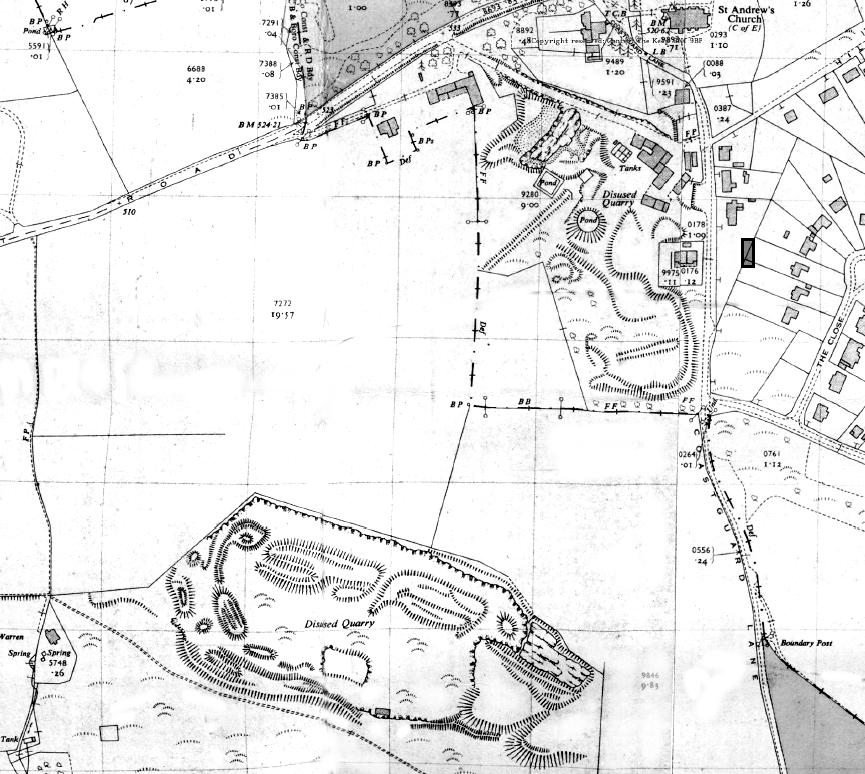 The two quarries after the War, when both had become disused. The rail line had run from the north-west facing side of Warren Quarry to the embankment pointing in its direction in Fairlight Quarry.Both quarries - together known as Fairlight Quarry - were heavily in use during the Second World War, and were of almost strategic importance, because Belgium had been a key source of this type of sand in peacetime, but it was then unavailable from there. The Fairlight sand was said to be required for high quality military optical items such as binoculars and gun sights. In the Warren Glen quarry stands a windowless brick building with a concrete roof. This was probably built as a wartime air-raid shelter, as it exactly matches the design of the several surviving air-raid shelters still to be seen in Hastings. It may also have been used as a blast shelter for workers using explosives in the quarry, plus a store for those explosives. At its peak, Fairlight Quarry employed over 80 men and supplied sand to five glass firms.
The two quarries after the War, when both had become disused. The rail line had run from the north-west facing side of Warren Quarry to the embankment pointing in its direction in Fairlight Quarry.Both quarries - together known as Fairlight Quarry - were heavily in use during the Second World War, and were of almost strategic importance, because Belgium had been a key source of this type of sand in peacetime, but it was then unavailable from there. The Fairlight sand was said to be required for high quality military optical items such as binoculars and gun sights. In the Warren Glen quarry stands a windowless brick building with a concrete roof. This was probably built as a wartime air-raid shelter, as it exactly matches the design of the several surviving air-raid shelters still to be seen in Hastings. It may also have been used as a blast shelter for workers using explosives in the quarry, plus a store for those explosives. At its peak, Fairlight Quarry employed over 80 men and supplied sand to five glass firms.
1939 July - A Mr HJ Stent applied to Hastings Council for planning permission to 'develop the Fairlight Place Estate as a holiday resort'. This involved building a thousand bungalows on the fields to the south-west of Fairlight Place, a clubhouse, a bathing pool below the cliffs at Fairlight Glen, cafes and a big extension to the existing golf course. But the council meeting on 25 July turned down the application.
1939-45 - The Reserve probably saw much activity during World War Two, but it went largely unrecorded because of legal restraints on wartime reporting. It was feared that Hitler’s forces could land along this coast, so access to the area was barred and mines were laid along some of the beach. The tower of Fairlight Church was used as an observation post. Bombs landed in several places, with Fairlight Coastguard Station suffering a hit. Five anti-aircraft batteries were set up in the borough, including one on the East Hill. These shot down ‘doodlebugs’ - V1 rockets - in 1944. A V1 fell on the farmhouse at Shear Barn Farm on 20 July 1944, killing the occupant, Miss Ethel Maria Barnes, the last person in the borough to die as a result of enemy action.
c1940 - The large barn standing immediately to the north of New Barn Pond was demolished at about this time. The barn was probably called ‘new’ because it seems to have replaced another barn 100 yards to the south-east of it in the early 19th century. Some bricks and rubble remain of the ‘new’ barn, nothing of the old one. The site remained in use as a 'farm' for several years.
1940 - The RAF Fairlight Chain Home Low (CHL) Radar Station was set up on the north side of Fairlight Road, at what is now the picnic site adjoining Martineau Lane. This had two operating sites: one at today’s picnic site, the other in the field between there and Mill Lane. The rotating aerial radars, similar to today’s, were on 20- feet high gantries. They could detect low-flying aircraft, and became operational just before the start of the Battle of Britain, in September 1940. On the picnic site were also the station’s offices, accommodation, generators, etc. When Germany’s Doodlebug campaign began in June 1944 the station was quickly upgraded, with many more facilities and staff, and anti-aircraft guns surrounding the site. After the war ended, the station remained in use as a CHL station until the early 1950s, and then throughout the Cold War as an RAF Domestic Camp (living base) after the construction of the ROTOR station on Fairlight Head in 1952. The Domestic Camp was demolished in 1966, and the whole site cleared.
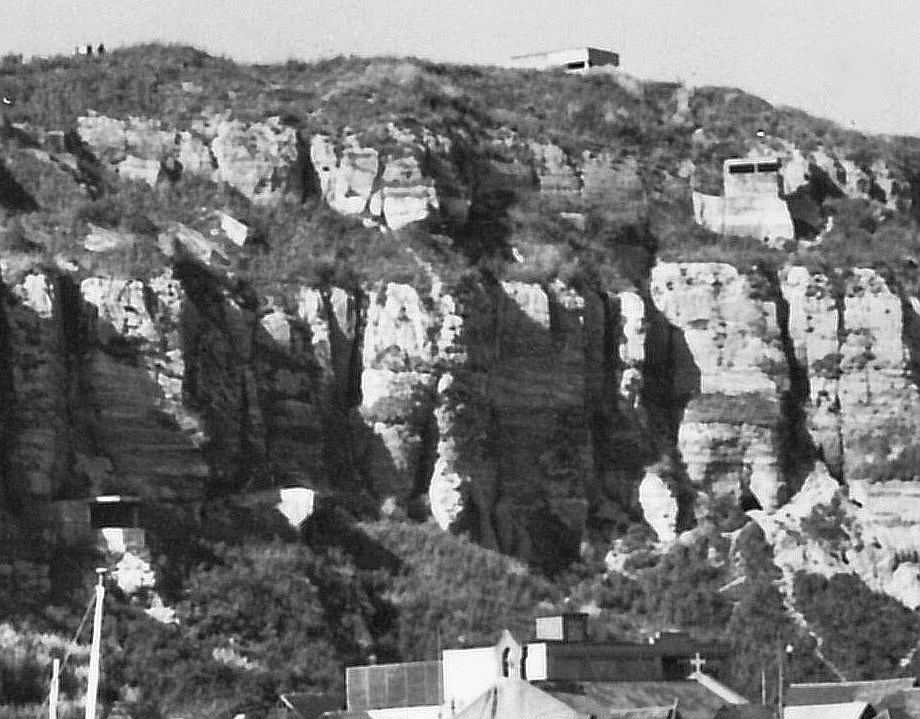 Three gun emplacements were built on the Rock-a-Nore cliffs in the Second World War. One is on top of the cliff; the second is just below it, to the right; and the third is in the bottom left corner, above the boat mast.1944 March - Major Carlisle Sayer gave permission for an overhead transmission line to be erected to supply electricity to New Barn Farm (the barn next to New Barn Pond) for Operation Pluto - PipeLines Under The Ocean. This operation supplied petrol to Allied forces in France after D-Day 6 June 1944,by laying 4½-inch pipelines under the Channel. The first pipelines, from the Isle of Wight to Cherbourg, opened on 12 August, followed by another set of lines between Dungeness and Ambleteuse near Boulogne in the autumn. It is not known what took place at New Barn Farm. Major Carlisle Sayer DSO MC served in the Hastings Battalion of the Home Guard during the war, being appointed second-in-command in May 1941, and commander in May 1944.
Three gun emplacements were built on the Rock-a-Nore cliffs in the Second World War. One is on top of the cliff; the second is just below it, to the right; and the third is in the bottom left corner, above the boat mast.1944 March - Major Carlisle Sayer gave permission for an overhead transmission line to be erected to supply electricity to New Barn Farm (the barn next to New Barn Pond) for Operation Pluto - PipeLines Under The Ocean. This operation supplied petrol to Allied forces in France after D-Day 6 June 1944,by laying 4½-inch pipelines under the Channel. The first pipelines, from the Isle of Wight to Cherbourg, opened on 12 August, followed by another set of lines between Dungeness and Ambleteuse near Boulogne in the autumn. It is not known what took place at New Barn Farm. Major Carlisle Sayer DSO MC served in the Hastings Battalion of the Home Guard during the war, being appointed second-in-command in May 1941, and commander in May 1944.
1945 onwards - After the war the Fairlight Mining Company running the Fairlight Quarry seems to have gone out of business, for official records show that in August 1948 Major Carlisle Sayer gave another company, Cooke’s Sand Quarries Ltd, a 21-year lease of just the northern part of the quarry (it would appear that the Warren Glen Quarry was not then in use). But in June 1953 the new company had a receiver appointed, and in July 1956 the 1948 lease was sold to Fairlight Sand and Developments Ltd. However, the 1957 Ordnance Survey map showed both quarries as being 'disused'. I (Steve Peak) remember playing in Warren Glen Quarry in the late 1950s and early ‘60s, and at that time it had clearly not been used for several years, and I believe nothing was done there after that. In 1963 Hastings Council acquired ownership of the two quarries and in September that year they were leased to Messrs Cole and Jennings and Co Ltd, but little came of it. The company appears to have ceased operations there in 1966, but a storm in November 1969 wrecked the surviving buildings in the northern quarry and forced the company to clear the site.
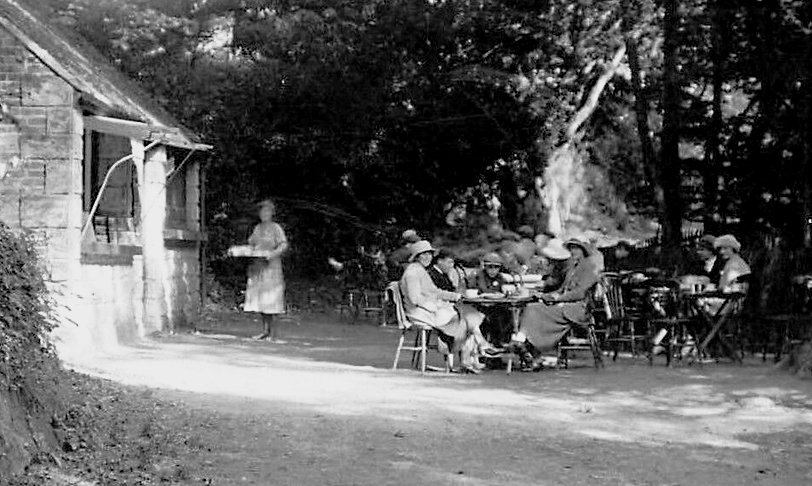 The popular cafe in Fairlight Glen (now gone).
The popular cafe in Fairlight Glen (now gone).
1947 Mid-Jan - The War Office announced it wanted to acquire Warren Glen and neighbouring land to use as a permanent field firing range. But Hastings Council strongly opposed the plan and three months later the War Office abandoned the scheme.
1948 Feb 14 - The wooden seat at Lovers’ Seat had been destroyed by the military during the war, so it was replaced on Valentine’s Day in memory of the late Mrs Elizabeth Todd of Fairlight Cottage. Major Carlisle Sayer provided the trunk of an oak tree as the bench on which to sit. In February 1949 the sea scouring the bottom of the cliffs at Lovers' Seat revealed mines. A military party blew them up and the area was fenced off.
1949 March 31 - The Hastings fishing boat Pioneer RX 255 ran on to the Hooks Ledge rocks under the cliff at Fairlight in a thick fog. The Hastings lifeboat and Coastguards were unable to find the vessel, even though the three crewmen could be heard shouting, and they all drowned. This was the biggest tragedy to hit the local fishing community for many years. 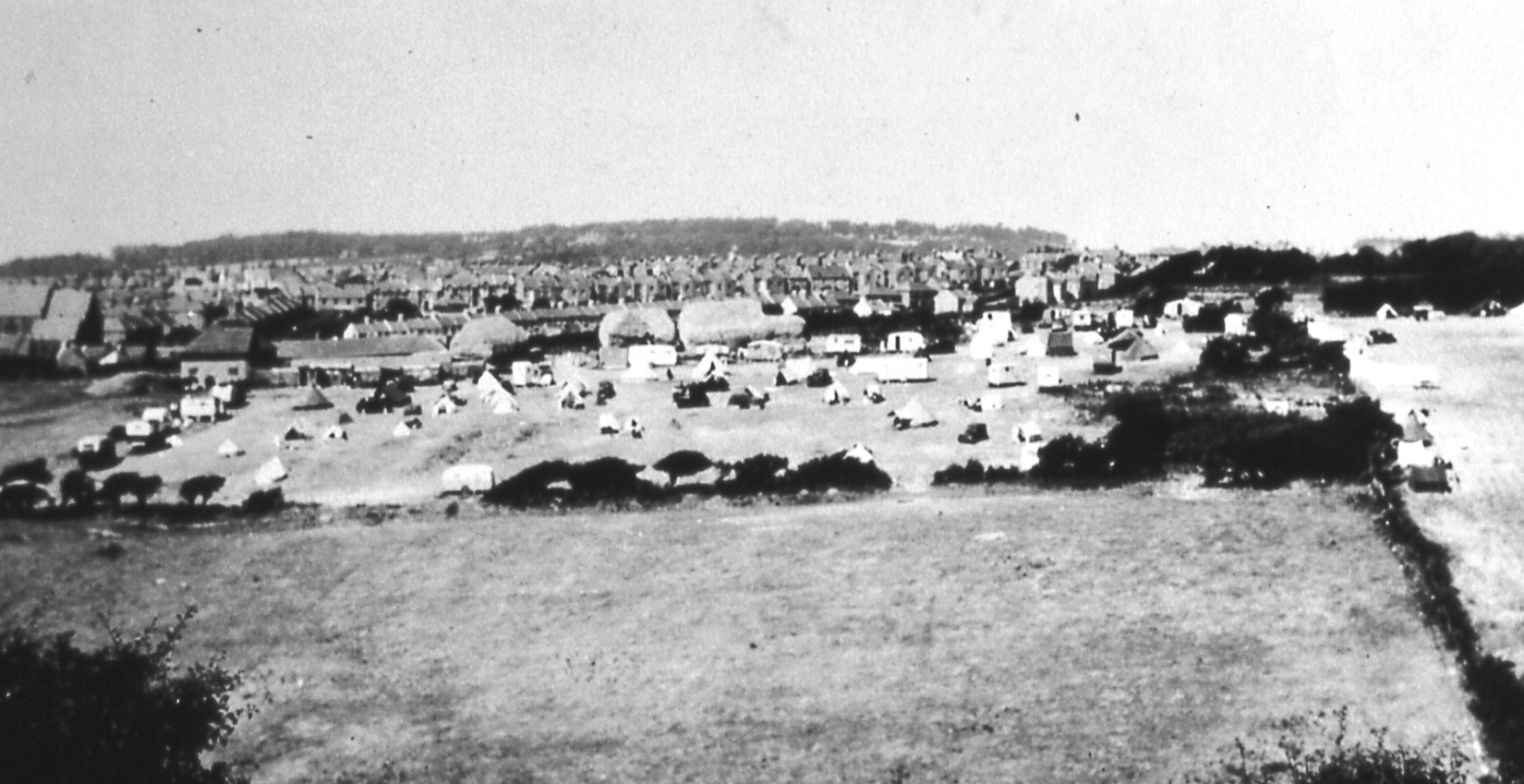 August 1949: Shear Barn Farm begins its re-birth as a giant caravan site, with the first tents in one of the fields. The bombed farmhouse had stood in the bottom-right corner of that field.1949 July 12 - Hastings Council gave planning permission for farmer Frederick (‘Freddy’) Funnell to use some of his land at Shear Barn Farm for caravans and camping for three years. In July 1948 Funnell had been fined £920 at Hastings Magistrates Court for selling milk by retail in excess of his permit under rationing. He was then a tenant of Shear Barn Farm fields, from his dairy base in Harold Road. In court, his solicitor said Funnell 'had abided by the law all his life. He was not a wicked man, as suggested by the prosecution.' But Hastings Council's planning committee was told on 2 September 1949 that Funnell had immediately broken conditions of the planning consent regarding cleanliness, pitch size and rubbish disposal. He was also using an adjoining coppice 'for purposes detrimental to public health', and had started unauthorised camping on another field. Funnell bought the farm from Major Carlisle Sayer in October 1949, paying £9,000 for 90 acres of fields around the farm buildings. Funnell's 1949 planning permission, and the way he bent the rules of it, were to be the beginning of his controversial transforming of the farm into a major caravan and camping site over the following years. This provoked much opposition from local residents, but not from key councillors who had too cosy a relationship with Funnell, said critics.
August 1949: Shear Barn Farm begins its re-birth as a giant caravan site, with the first tents in one of the fields. The bombed farmhouse had stood in the bottom-right corner of that field.1949 July 12 - Hastings Council gave planning permission for farmer Frederick (‘Freddy’) Funnell to use some of his land at Shear Barn Farm for caravans and camping for three years. In July 1948 Funnell had been fined £920 at Hastings Magistrates Court for selling milk by retail in excess of his permit under rationing. He was then a tenant of Shear Barn Farm fields, from his dairy base in Harold Road. In court, his solicitor said Funnell 'had abided by the law all his life. He was not a wicked man, as suggested by the prosecution.' But Hastings Council's planning committee was told on 2 September 1949 that Funnell had immediately broken conditions of the planning consent regarding cleanliness, pitch size and rubbish disposal. He was also using an adjoining coppice 'for purposes detrimental to public health', and had started unauthorised camping on another field. Funnell bought the farm from Major Carlisle Sayer in October 1949, paying £9,000 for 90 acres of fields around the farm buildings. Funnell's 1949 planning permission, and the way he bent the rules of it, were to be the beginning of his controversial transforming of the farm into a major caravan and camping site over the following years. This provoked much opposition from local residents, but not from key councillors who had too cosy a relationship with Funnell, said critics.
1949 July 25 - Following Major Carlisle Sayer’s problems with maintaining the clifftop footpaths, Hastings Council announced that he had agreed in principle to sell the paths, plus Fairlight and Ecclesbourne Glens and part of Warren Glen, to Hastings Council. In return for giving the Major just £10 in cash, but with expensive services added, the council would receive 215 acres, including all the cliff area from Ecclesbourne Glen stream to the start of the Firehills. The Council would then own all the 2.9 miles of cliff area between Tackleway and the east end of the Firehills. But the complex negotiations over the deal lasted 18 months, and were not finalised until 18 January 1951. Major Sayer was disposing of the steep glens and cliff edges that were unusable as farmland and expensive to maintain, and much of which were also to be designated as protected environmental sites in the coming years. So the Major, an astute businessman, spent those 18 months negotiating strict conditions on the conveyance that required the council to fence off the steep glen sides and cliff edge, divert several paths and create a new vehicle access track into Fairlight Glen from Barley Lane (which today is the only such access). After this work was carried out, the farmland that he retained was to be safer for cattle and with restricted public access, enabling him to use it more intensively and therefore more profitably. Not only did the council have to spend almost £2,200 straightaway on this work, but they had to pay the £263 bill that Major Carlisle Sayer incurred from his solicitor and surveyor for the negotiations. The council gave the land the official title of the ‘Cliffs and Glens’.
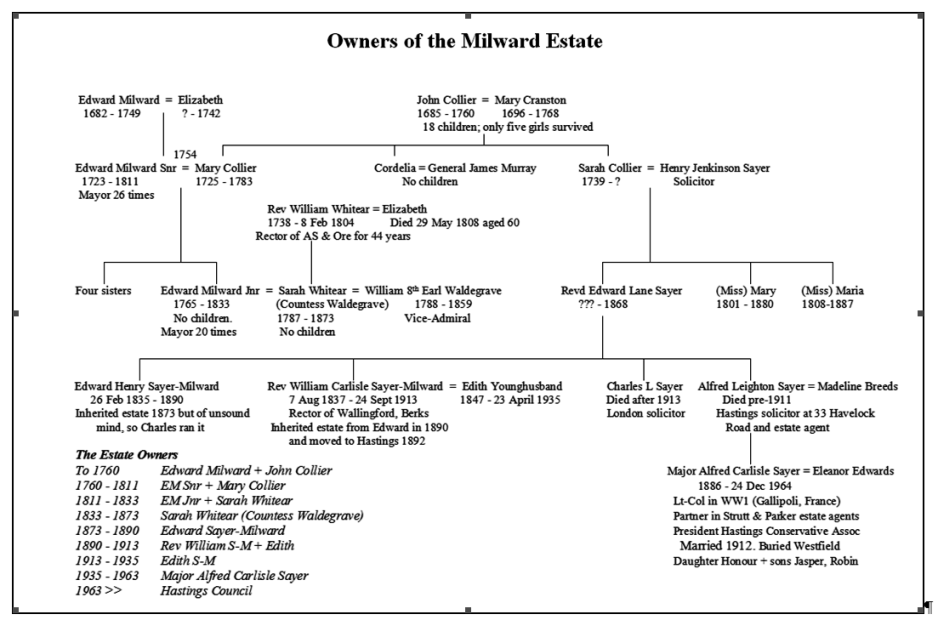 A family tree showing the owenrs of the Milward Estate. Drawn by Steve Peak.
A family tree showing the owenrs of the Milward Estate. Drawn by Steve Peak.
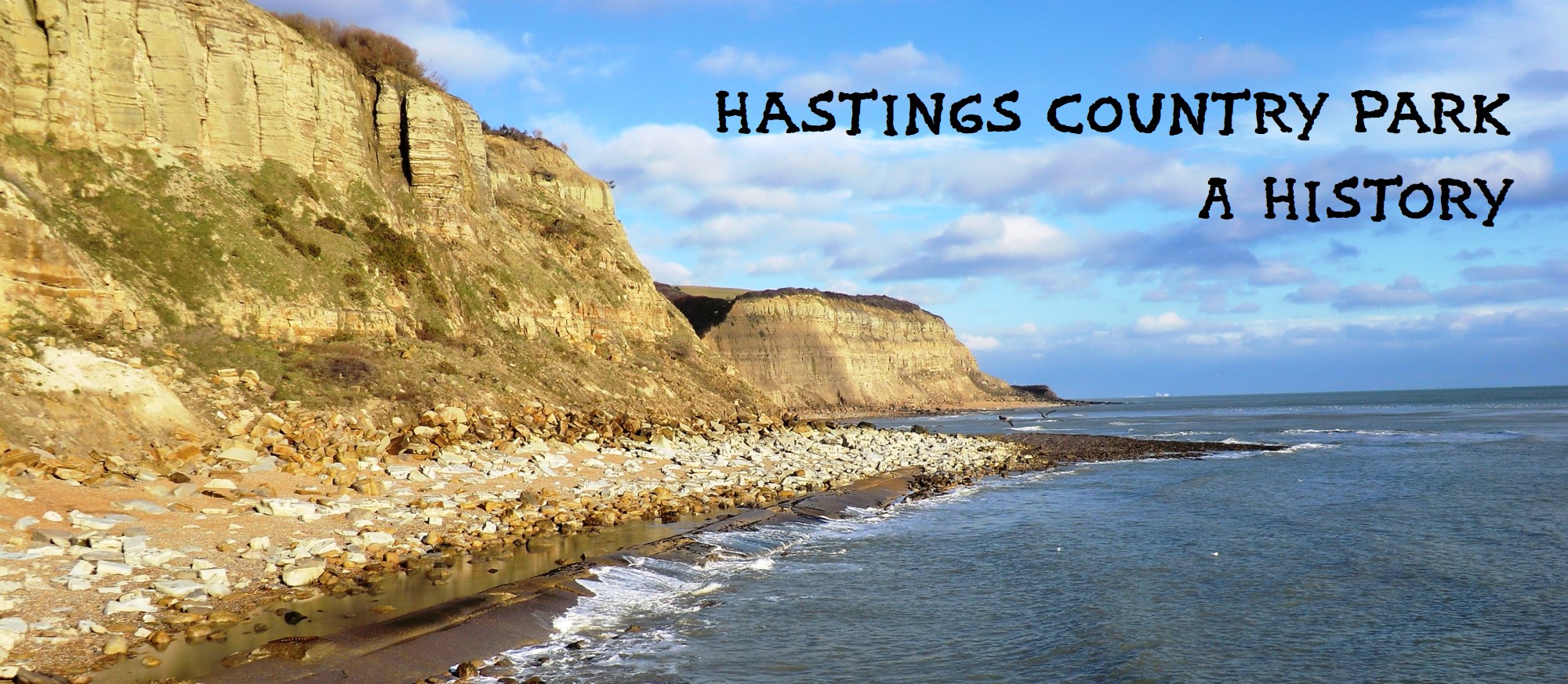

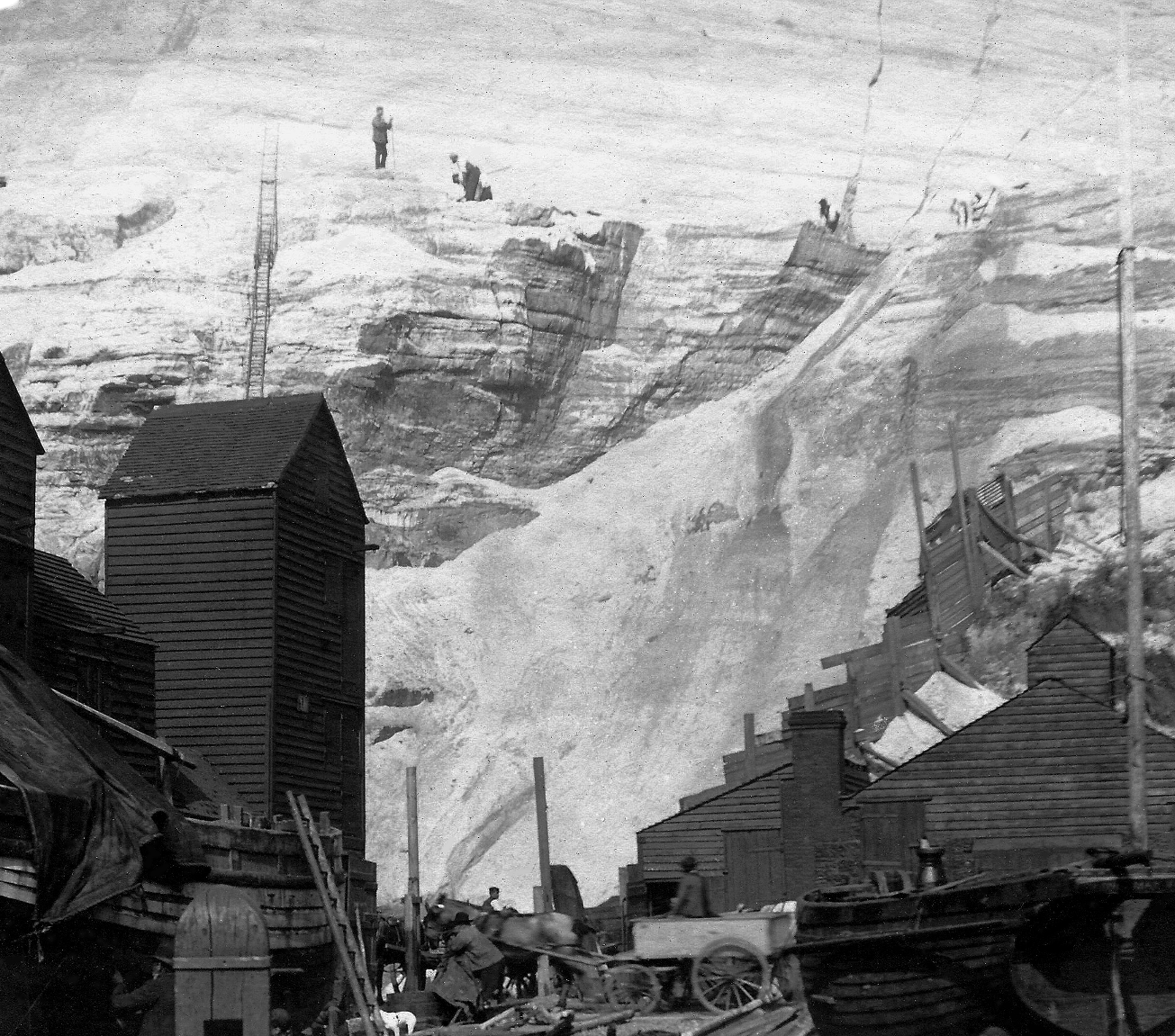
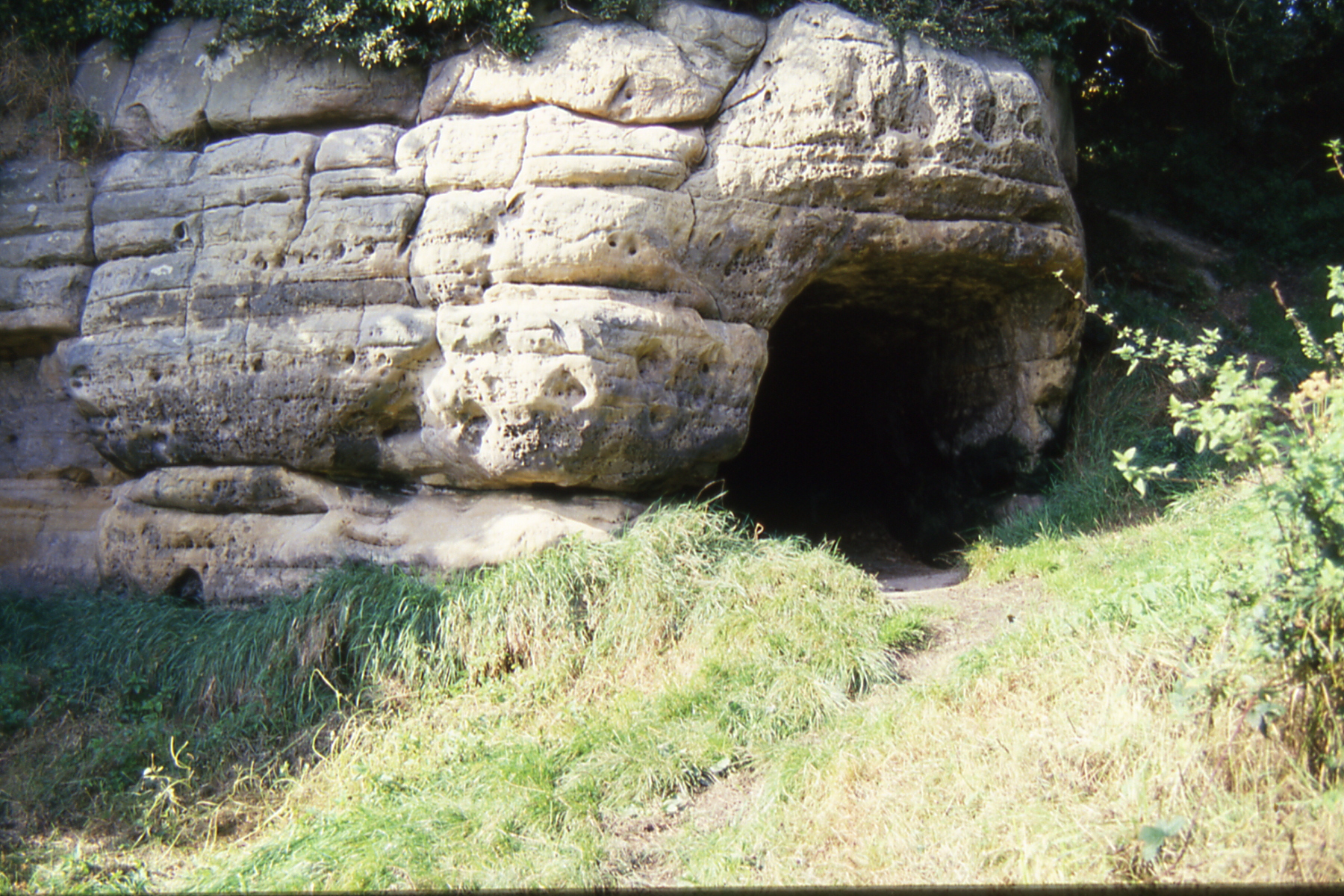

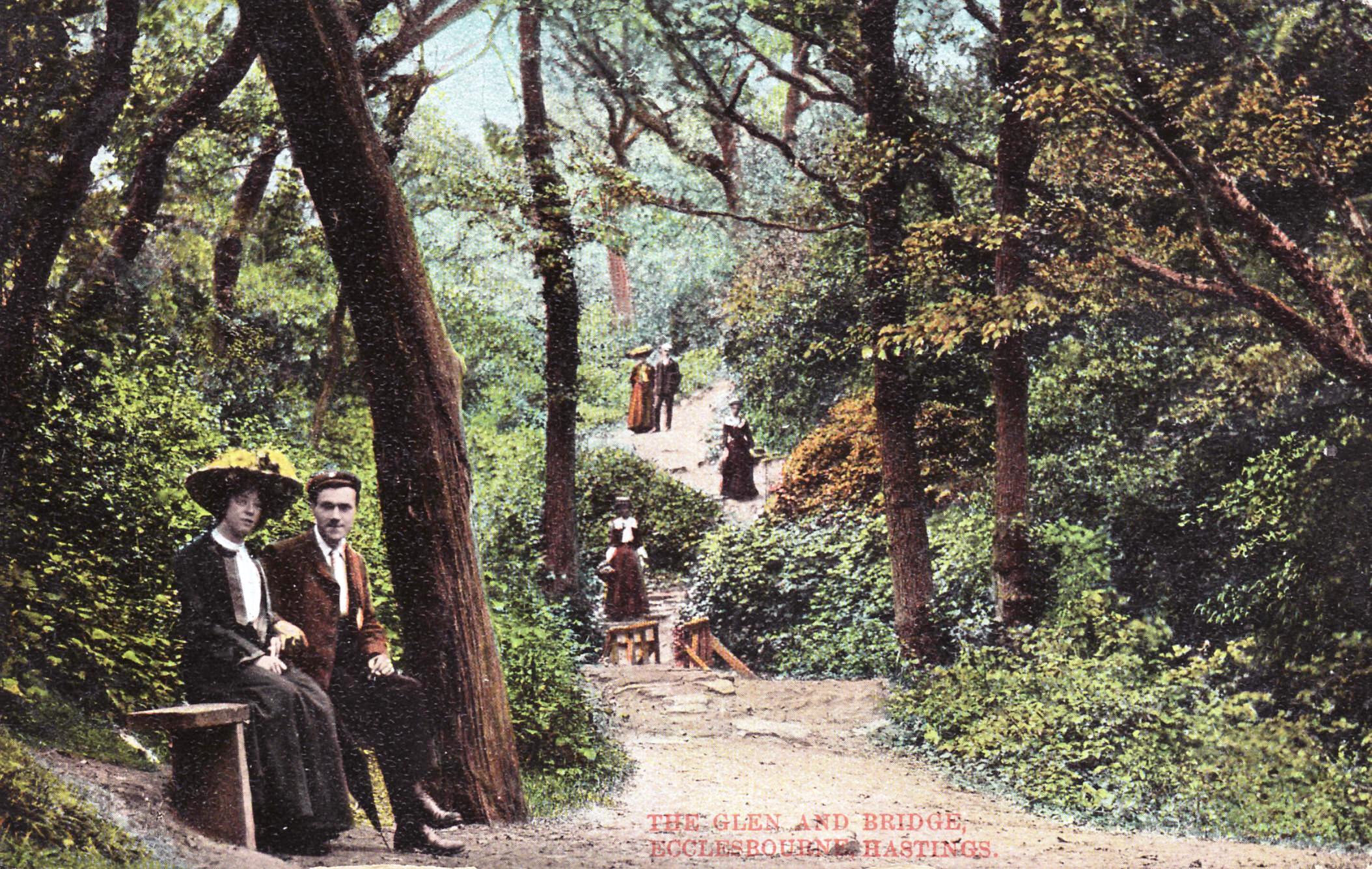
.png)
